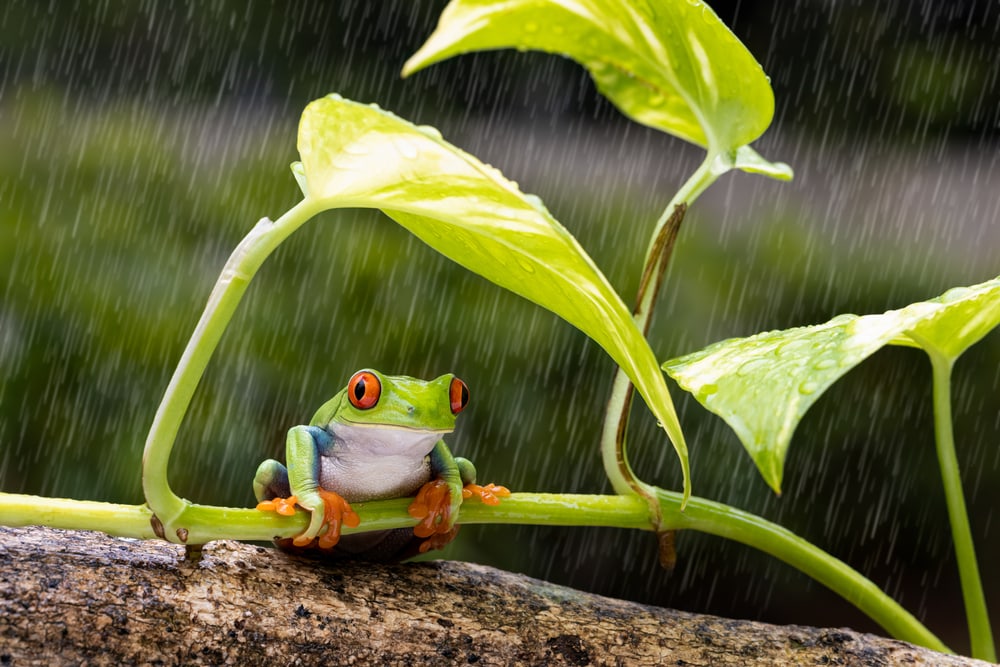
Frogs come in a variety of shapes, sizes, and colors. Every frog species has some really cool and unique features of their own. Frogs can be found just about anywhere and will more than likely stumble upon a frog’s home if you’re adventuring near a body of water.
Ever wondered what type of frog you stumbled upon in your backyard or perhaps noticed one camouflaging in a tree while exploring a forest? We’ve made up a long list of different types of frogs that live all around the world.
This in-depth frog guide will discuss a multitude of frog types, their behaviors, habitat, diet, and some neat characteristics that each frog has. Before we jump into all the facts, let’s first get a general understanding of what frogs are and where they fit in the animalia kingdom.
What Are the Different Types of Frogs?
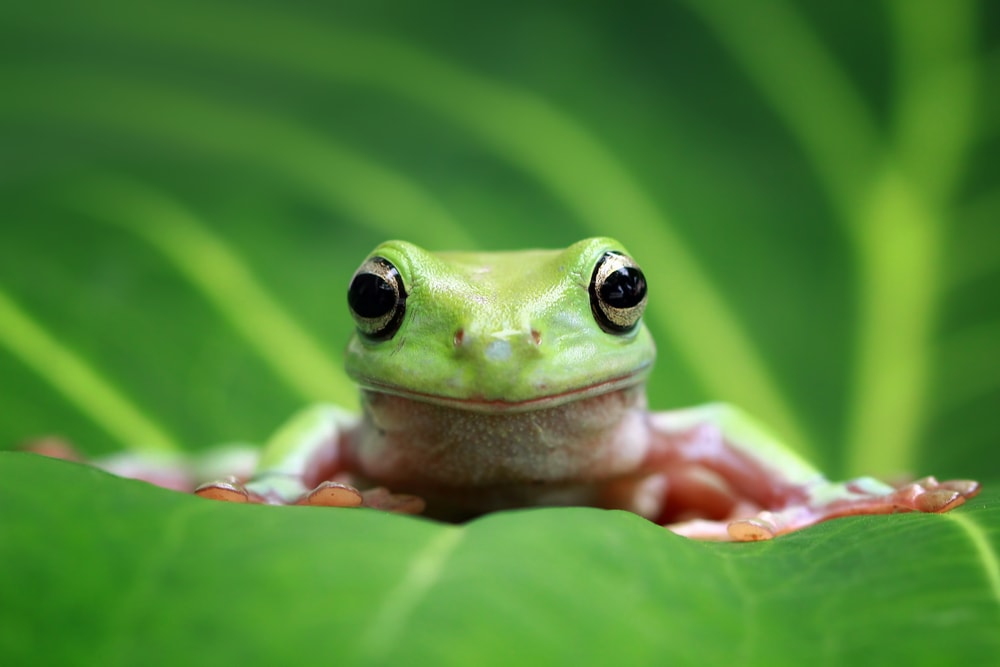
Frogs are in the amphibia class. The word “amphibian” stems from Greek and means “double life” because they spend their lives on land and in water.
There are more than 5,000 species of frogs and the number continues to grow. Some frog species spend much of their life in hiding, are very small, or live high in tree tops so trying to find some of these critters can prove to be quite difficult.
Both frogs and toads are a part of the anura order. Anura means that they lack tails. Once frog and toad eggs hatch and begin the tadpole phase, they do possess a tail but once they mature into adults, it disappears. We will look deeper into the frogs vs. toads topic a little later to answer the burning question of whether toads are actually considered frogs.
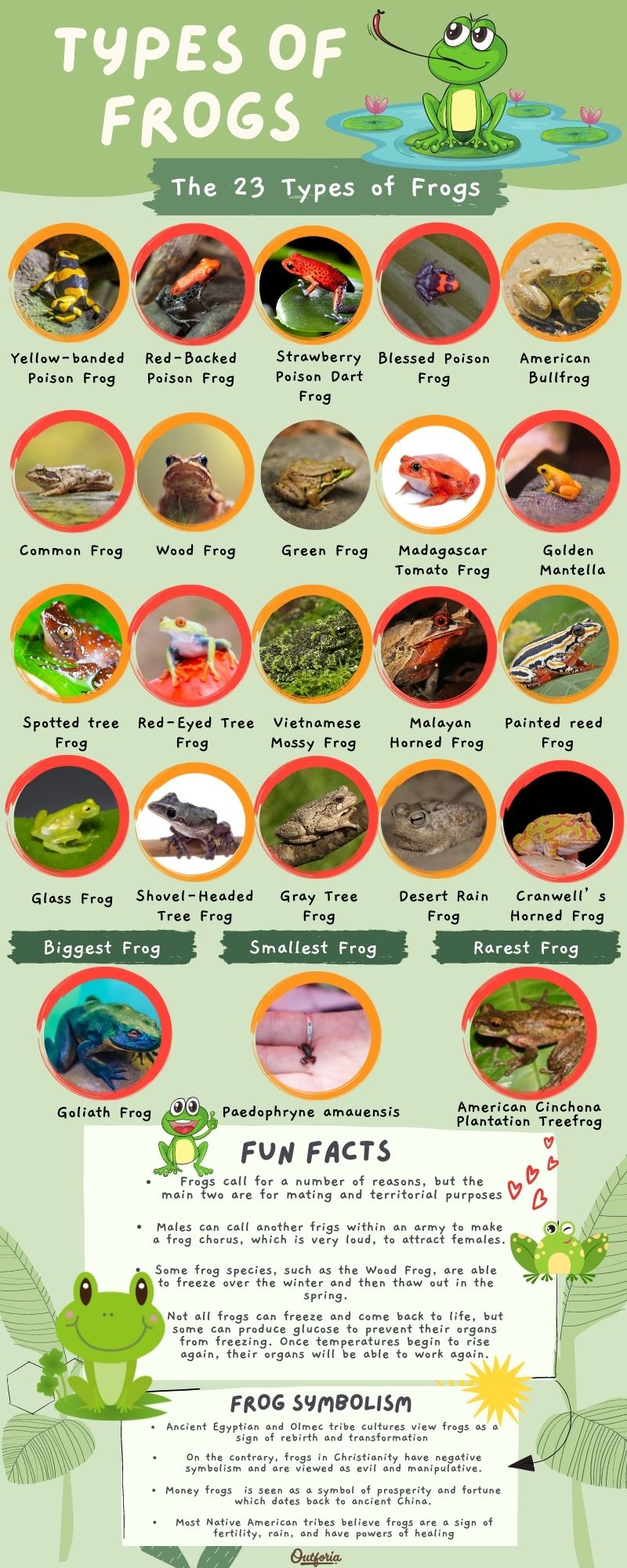
share this image on your site
<a href="https://outforia.com/types-of-frogs/"><img style="width:100%;" src="https://outforia.com/wp-content/uploads/2022/03/types-of-frogs-infographics-2-410x1024.jpg"></a><br>types of frogs <a href="https://outforia.com">Outforia</a>23 Different Frog Species with Facts and Pictures
1. Poison Dart Frogs (Dendrobatidae)
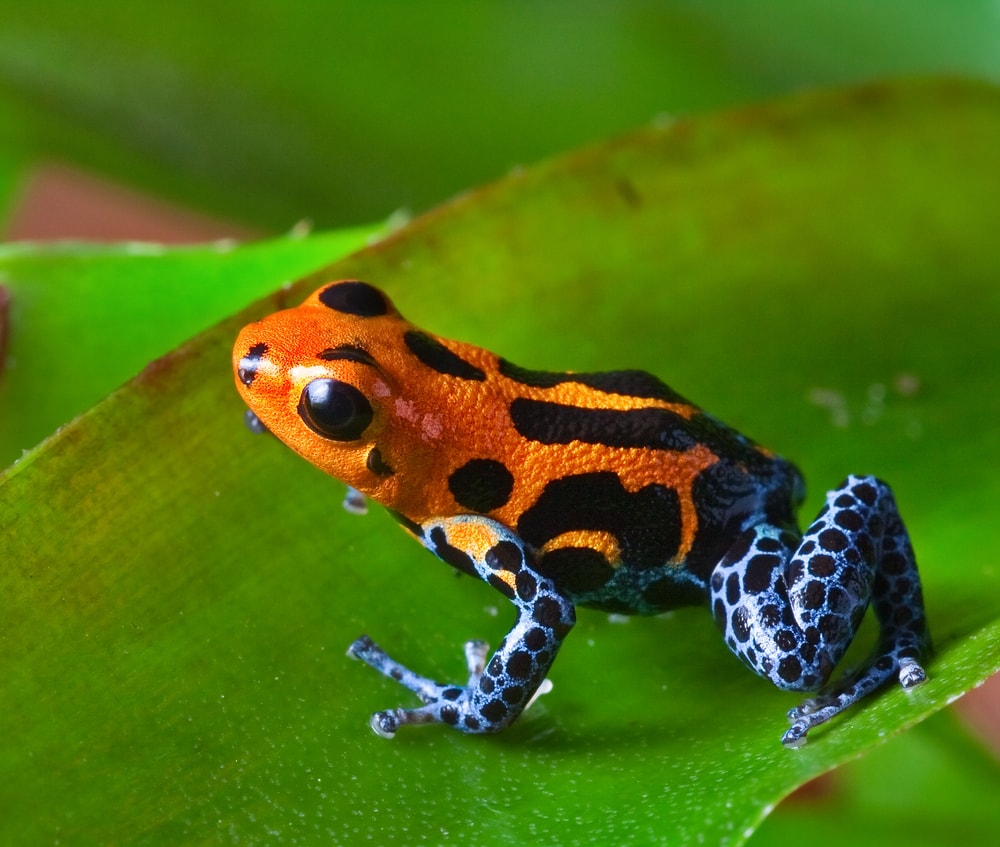
Poison dart frogs are known for their vibrant colors and unique patterns. These colorful critters belong to the Dendrobatidae family. As it says in their name, poison dart frogs are poisonous and scientists believe the toxins come from their diet of formicine ants.
Some poison dart frogs are more poisonous than others and handling them can be dangerous to humans depending upon their level of toxicity. The color and toxins of these frogs help deter predators from eating them.
1.1 Yellow-Banded Poison Dart Frog (Dendrobates leucomelas)
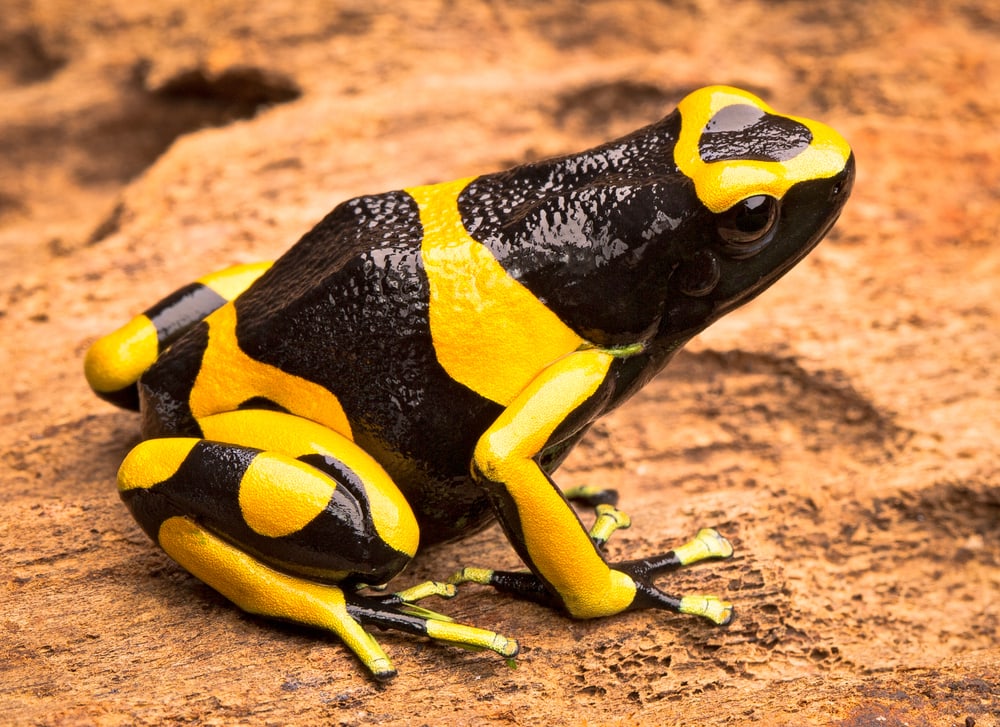
Geographic Location and Habitat
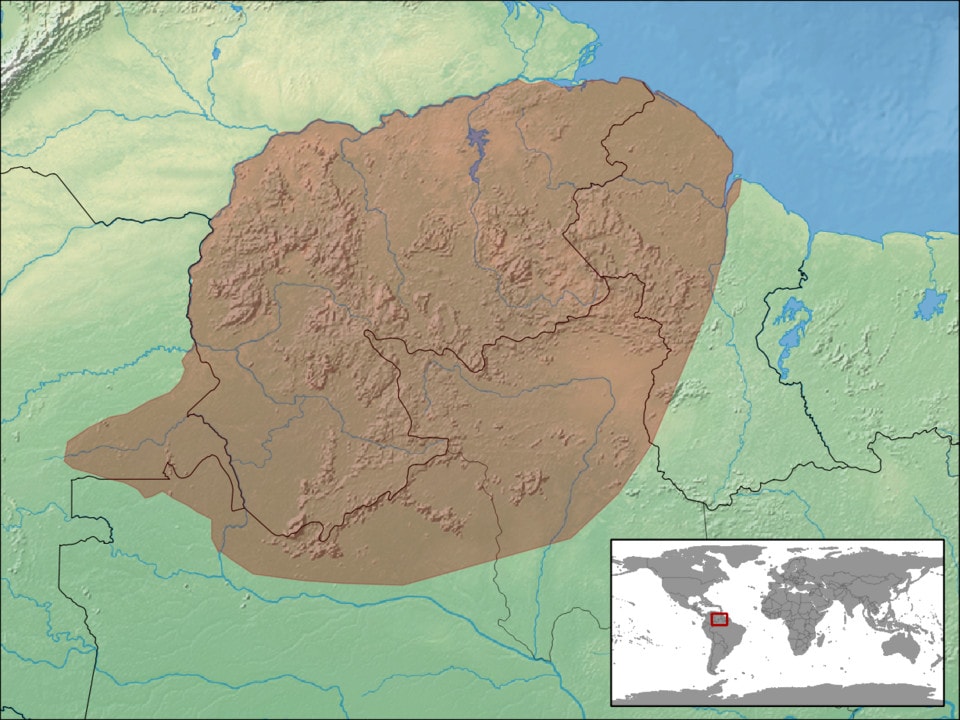
rbrausse, IUCN Red List / CC BY-SA 3.0 / Wikimedia commons
Yellow-banded poison dart frogs live in the neotropical region of northern South America, specifically in Venezuela, Guyana, southeastern Colombia, and northern Brazil.
Unlike many other frogs that like to cling to trees at higher elevations, yellow-banded poison frogs are terrestrial and hang around the tree trunks on the forest floor. Tadpoles mature in pools of water within bromeliads, which are flowering plants native to tropical regions.
Characteristics
Yellow-banded poison frogs have a color pattern of yellow bands that cross over their black body. The yellow bands tend to separate as the frogs get older and turn into spots. They have aposematic coloration, meaning that their bright yellow color and markings serve to deter predators.
These frogs are diurnal, meaning they are more active during the day. They can climb into trees in search of food, but often remain close to the forest floor. Males are highly territorial and can become aggressive if another male frog approaches their territory they chose for breeding.
Reproduction and Life Cycle
Many male frogs will call for females and the female frog will compete for the male. Their breeding season is fairly short and only occurs between February and March, which is when the male will use a series of vocalizations to attract females.
Once a female lays eggs and they hatch into tadpoles, the parent frogs will distribute the tadpoles into the water pockets of bromeliads until they metamorphose into froglets. Each tadpole gets its own pocket and will wriggle rapidly if approached by an adult frog to let them know that spot is taken. If this signal is ignored, the existing tadpole will eat the new tadpole.
Bunches of frog eggs are called “clutches”. A female yellow-banded frog can lay 2-12 eggs in a clutch and up to 1000 eggs throughout the breeding season. It takes approximately 2-3 months for tadpoles to metamorphose into froglets and the average lifespan of these frogs is 5-7 years in the wild.
Diet
Yellow-banded poison dart frogs are insectivores. Their diet consists mostly of:
- Ants
- Termites
- Crickets
- Small beetles
- Spiders
1.2 Red-Backed Poison Frog (Ranitomeya reticulata)
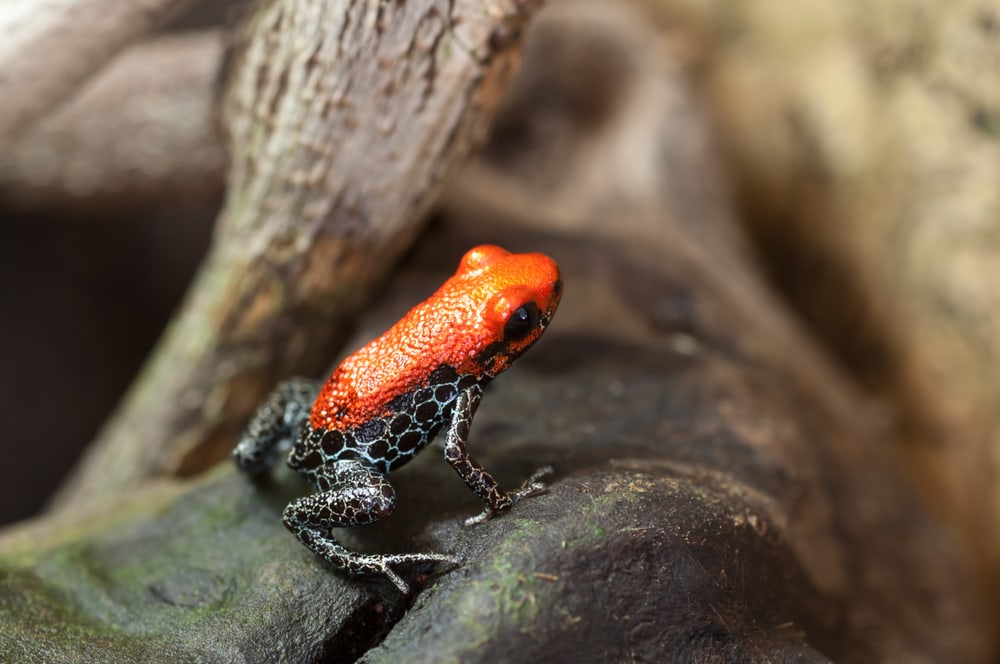
Geographic Location and Habitat
Red-backed poison frogs are terrestrial and spend their life on the forest floor in leaf litter and near tree roots. They live in the tropical lowlands of the Amazon in Peru and Ecuador. The tadpoles live inside of bromeliads until they mature into froglets.
Characteristics
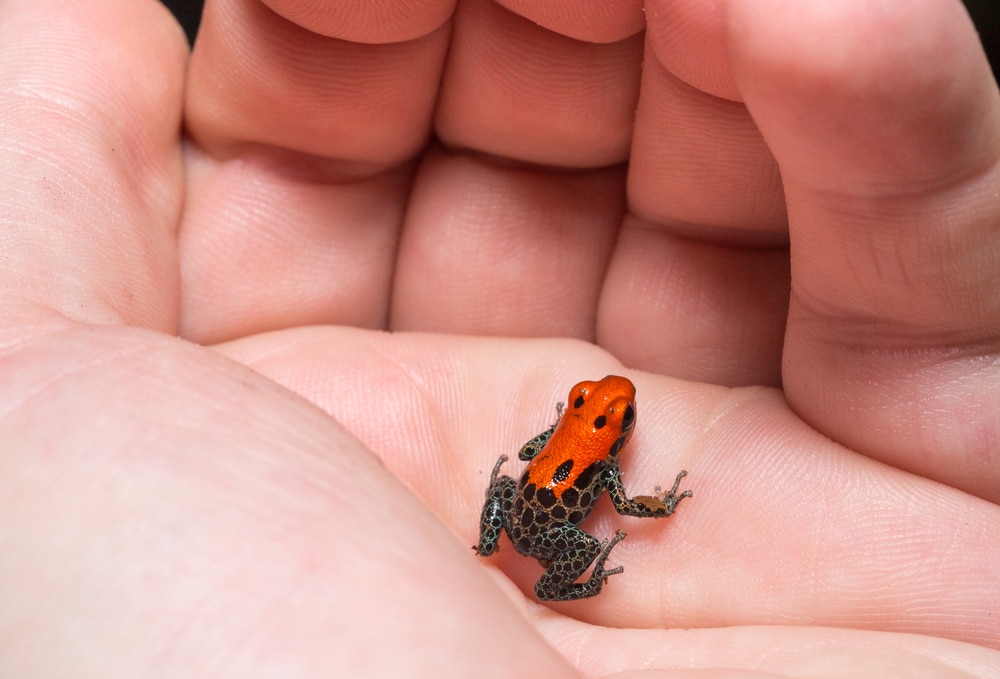
Red-backed poison frogs have distinct coloration patterns. They are bright red from the top of the head leading down to the lower back. The lower half and sides of these frogs are black with light blue, white, yellow, or orange circular patterns. Their eyes and underbelly are black. They can grow to be about 0.5-0.75 inches (1.2-2 cm) in length.
The conservation status for red-backed poison frogs are Least Concern according to the International Union for Conservation of Nature (IUCN) as of 2017. Their habitat in the Amazon is threatened by rainforest degradation and global climate change which could affect their reproduction behaviors. The international pet trade is another major threat to these frogs.
Reproduction and Life Cycle
Males attract females during the mating season and once a female picks a male, she will stomp her feet to let the male know she is ready to mate and lay eggs. Males select a specific site that is acceptable for laying eggs and will lead the female there.
Females lay their eggs in wet leaf litter and males fertilize the eggs. Once the eggs hatch, the male will carry one to three tadpoles at a time to pools of water. The female parent feeds the tadpoles unfertilized eggs for several weeks until they become froglets.
Diet
The diet of a red-backed poison frog consists mostly of small insects, such as:
- Ants
- Fruit flies
- Termites
- Small crickets
- Tiny beetles
1.3 Strawberry Poison Dart Frog (Oophaga pumilio)
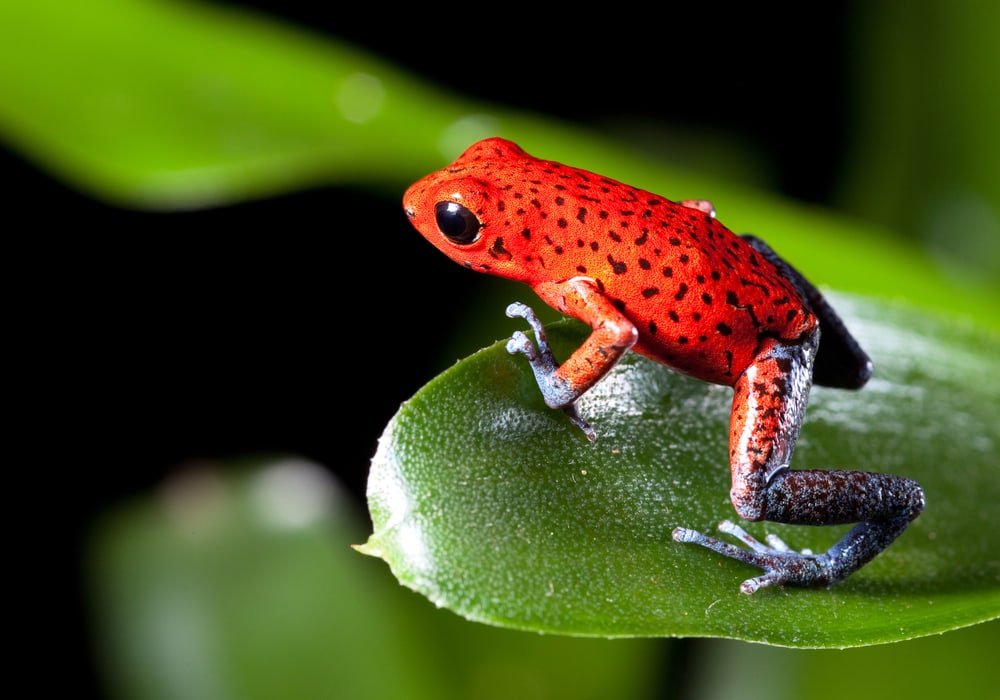
Geographic Location and Habitat
Strawberry poison frogs are native to neotropical regions and can be found in the rainforests of Central and South America. They are terrestrial and live in habitats that have an abundance of water necessary for breeding. Strawberry poison frogs can also be found living in cacao and banana groves.
Characteristics
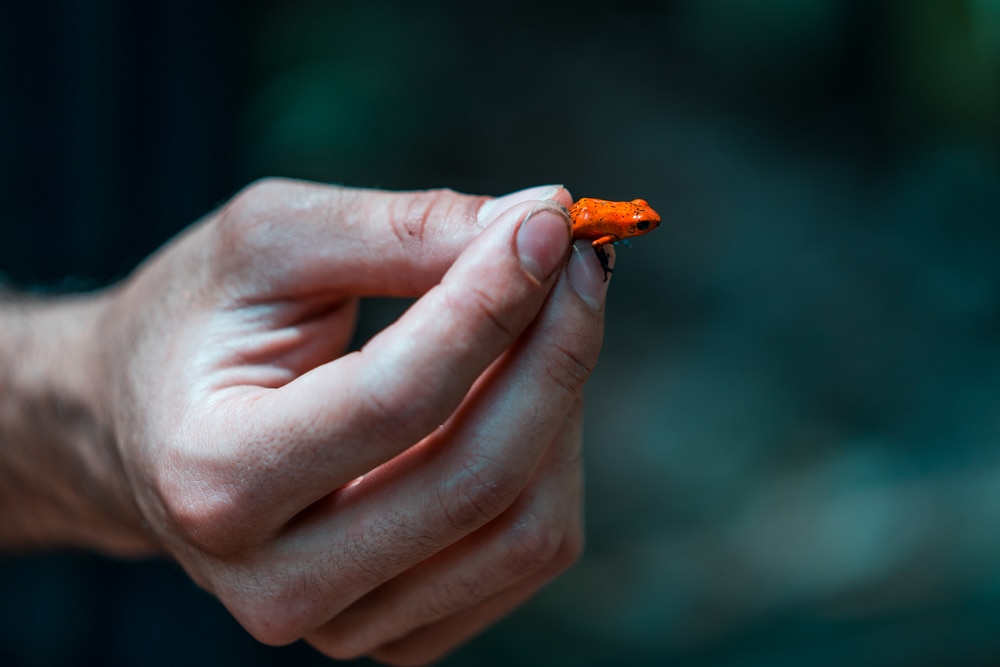
The size of strawberry poison dart frogs ranges from 0.5-0.75 inches (17-24 mm) in length. Their name speaks for their appearance as a majority of their body is red with black speckles that resembles a strawberry. They have blue legs that are heavily speckled with red or dark brown to black spots.
Although they are known for their vibrant red color, strawberry poison frogs can also be blue, yellow, white, green, or black. It is quite uncommon for poison frogs to have this many color variations, which makes the strawberry poison frog variations pretty unique.
The conservation status of these critters are of Least Concern according to the IUCN as of 2014. Their threats of habitat loss are mostly in relation to urbanization, logging, and the international pet trade.
Reproduction and Life Cycle
Strawberry poison frogs can breed year round, but often do so only in wet conditions so the female is able to carry the tadpoles to pools of water. Both male and females use chirping calls to announce that they are ready to mate. Males are very territorial and will become aggressive if another male approaches their territory which can result in a wrestling match.
Females will lay the eggs on the forest soil or leaves and once they hatch, they will carry the tadpoles to bromeliads. It takes approximately six to eight weeks for the tadpoles to metamorphose into froglets.
Diet
A large portion of the strawberry poison frog’s diet consists of formicine ants and sometimes mites. The formicine ants are how these poison frogs are able to produce their toxicity.
1.4 Blessed Poison Frog (Ranitomeya benedicta)
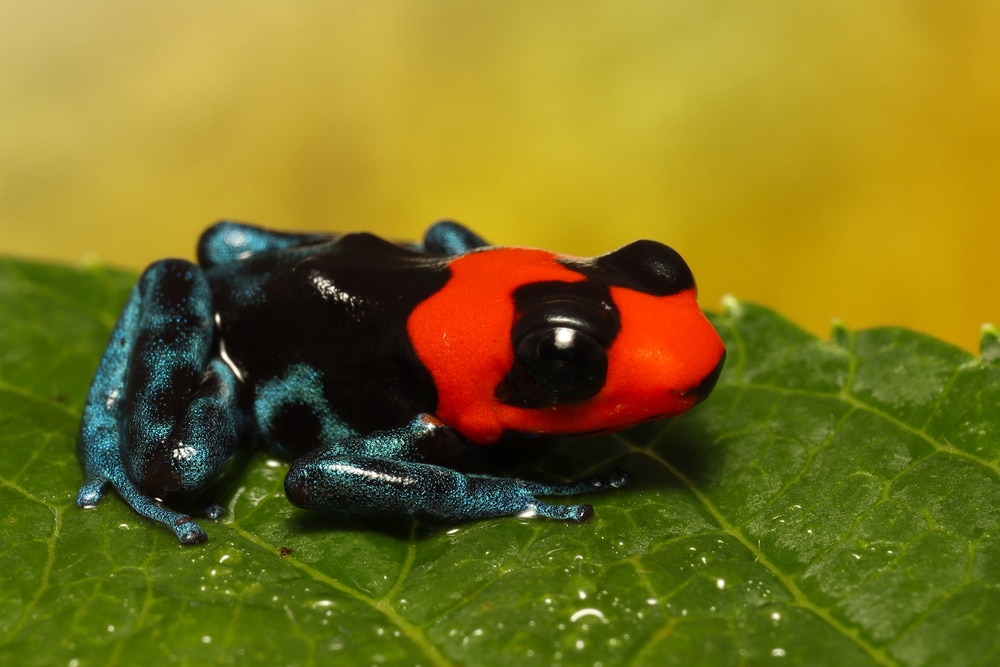
Geographic Location and Habitat
Blessed poison frogs are native to the rainforests of northeastern Peru. They are terrestrial and arboreal and mainly reside in the lowlands of the Amazon rainforest amongst bromeliads and fallen tree branches.
Characteristics
Blessed poison frogs are a diurnal species with beautiful color patterns. Their head is often a fiery red to orange color with black blotches surrounding their eyes. Their bodies are black and sometimes covered with mesh patterns that range in light colors such as blue, light gray, or white.
The IUCN last assessed the Blessed Poison Frog in 2017 as Vulnerable. The adult population is decreasing due to deforestation and illegal capture and trade.
Reproduction and Life Cycle
Female blessed poison frogs will lay their eggs in humid leaf litter. Like many poison frogs, the parent frogs will transport the tadpoles once they hatch to pools of water found in bromeliads.
Diet
Blessed poison frogs eat a number of small insects that are present around the forest floor, such as ants and fruit flies.
You may also like: Venomous Hoppers: The Incredible World Of Earth’s Most Poisonous Frogs And Toads
2. True Frogs (Ranidae)
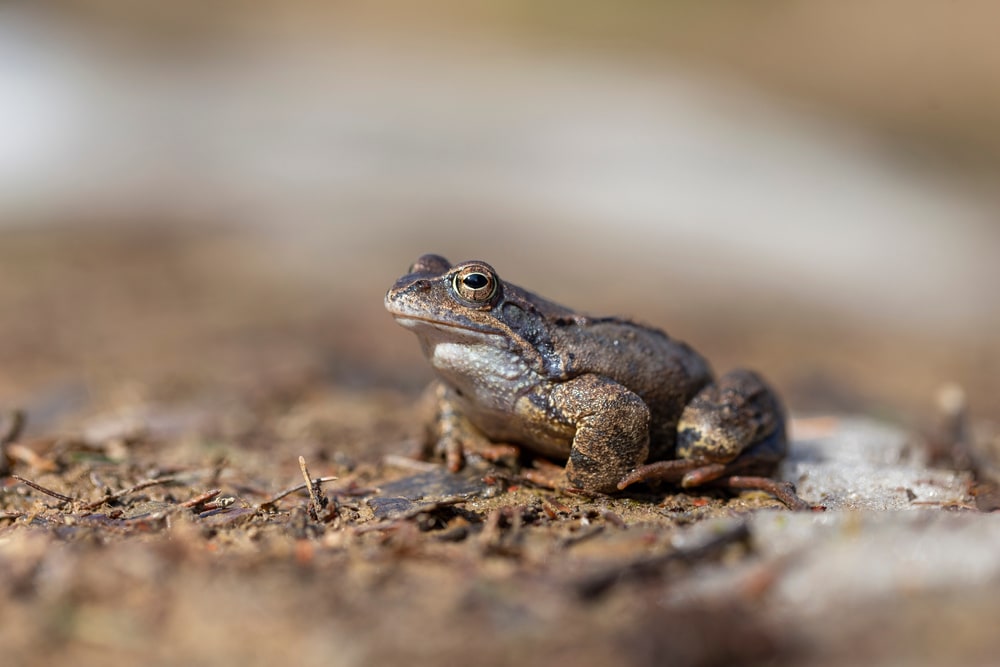
True frogs are a part of the Ranidae family and are widely distributed across the world. These frogs are typically the ones you may see hanging around your backyard close to small bodies of water such as rivers, ponds, or streams. There are more than 600 species within this frog family.
2.1 American Bullfrog (Lithobates catesbeianus)
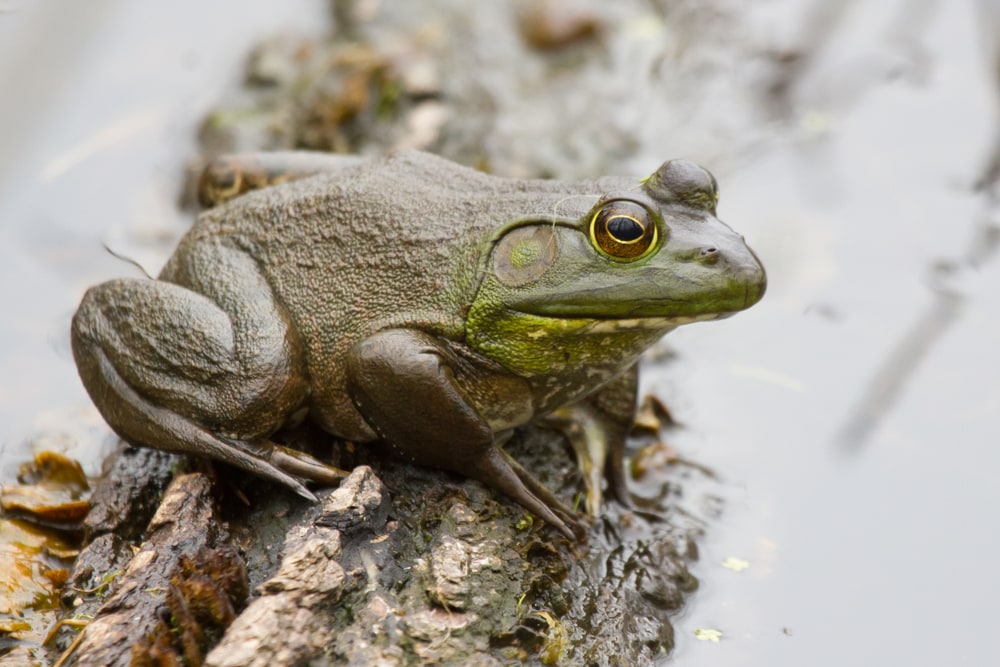
Geographic Location and Habitat
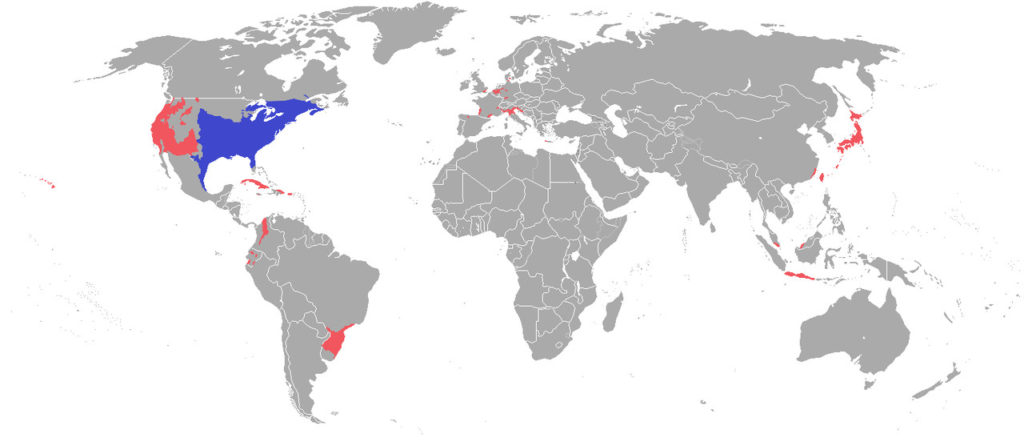
Osiris / CC BY-SA 3.0 / Wikimedia common
American bullfrogs are the largest frog species in North America and can be found almost anywhere across the United States. They like to live around small bodies of water and in wetlands.
Characteristics
American bullfrogs can be a mixture of green and brown in color and may also have yellow, graameriy, or white coloration on their underbellies. They are the largest frog in North America, reaching sizes of eight inches (20 cm) or more. Size may vary depending upon the region they live in.
Bullfrogs will hibernate during the winter months by burying themselves in mud or soil pockets. Their state of hibernation is called torpor.
Reproduction and Life Cycle
Unlike many of the other frog species we’ve discussed, American bullfrog breeding is aquatic. Females lay their clutches in permanent bodies of water in the spring and early summer. Males select a breeding territory and it is up to the female to choose their mate by entering the selected area.
Females will often choose a male that is closer to their age. The eggs are laid on the surface of the water and take three to five days to hatch. A female can have as many as 20,000 eggs within one clutch.
Froglet metamorphosis varies in time depending on location. In southern regions of North America, froglets can metamorphose within three months while others in northern regions can take up to three years.
Diet
American bullfrogs feed on a number of insects and aquatic creatures. Tadpoles mainly feed on algae and small invertebrates.
Much of their diet consists of:
- Insects
- Worms
- Crayfish
- Smaller frogs
- Small turtles
- Small mammals
2.2 Common Frog (Rana temporaria)
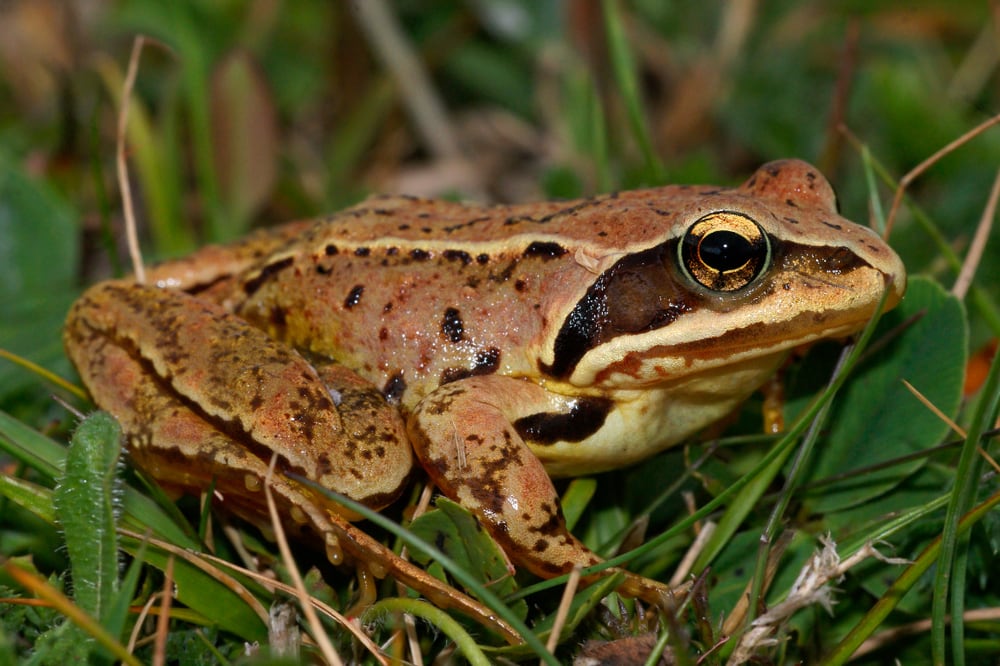
Geographic Location and Habitat
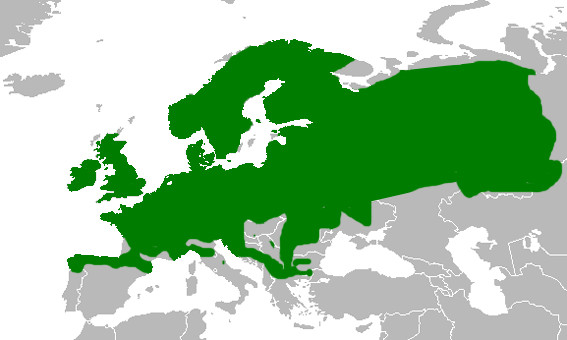
Osado / PUBLIC DOMAIN / WIKIMEDIA COMMONS
Common frogs are native to the United Kingdom, but found all across Europe. They find their homes in permanent bodies of water such as ponds and lakes.
Characteristics
Common frogs are often light brown to tan and green in color with dark brown markings. Their underbelly is light tan to white in color with various tan splotches and markings. Female common frogs grow to be 5 inches (13 cm) and males can be 3.5 inches (9 cm).
Once winter rolls around, common frogs will bury themselves in mud or under rocks or vegetation until spring.
Reproduction and Life Cycle
Common frogs begin breeding when they are two to three years old. Breeding season begins in the spring and males attract females with a vocalization call.
Females will lay her eggs in a stagnant body of water and they will hatch within two to four weeks. Female common frogs can lay as many as 2,000 eggs within a clutch. Tadpoles take approximately four months to begin growing legs. By the summer, the froglets will have matured into adults.
Diet
Common frog diets are insectivores and carnivores. Tadpoles will eat algae until they mature into froglets.
Adult Common Frog diet mainly consists of:
- Snails
- Slugs
- Worms
- Insects
2.3 Wood Frog (Lithobates sylvaticus)
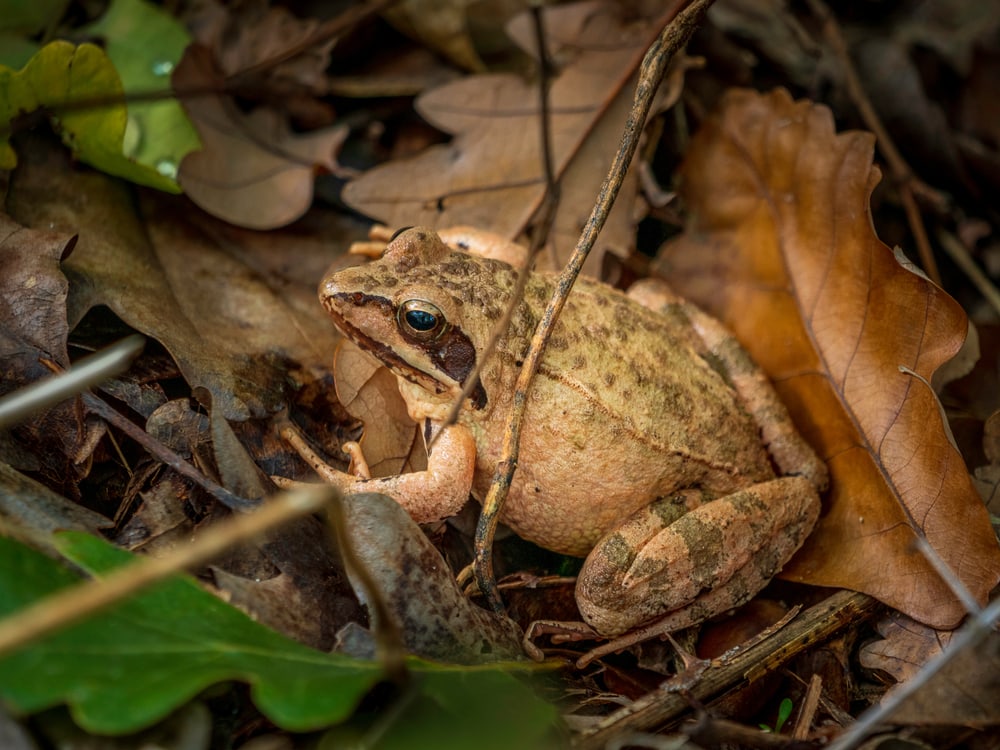
Geographic Location and Habitat
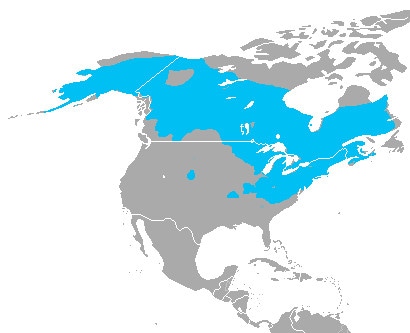
Craig Pemberton at en.wikipedia / CC BY-SA 3.0/ Wikimedia commons
Wood frogs are found scattered across the United States and Canada, with higher numbers in the northeastern states and Alaska. They live in a wide variety of habitats such as woodlands, temperate forests, and wetlands.
Characteristics
Wood frogs can vary in color from light reddish-brown to light gray or greenish gray. They have dark brown markings next to their eyes on the side of the head and lead out towards the tip of the nose. These critters blend in well with the leaf litter on the forest floors.
Wood frogs can grow to be 1.5 to 3.25 inches (3.8 to 8.2 cm). Since they live in colder regions, wood frogs have a neat adaptation that allows them to freeze in colder months and thaw out once spring comes around again.
Reproduction and Life Cycle
Wood frog breeding season begins once temperatures begin to rise in late winter to early spring. They begin to migrate to wetlands as the females lay their eggs in ponds or streams.
Females lay hundreds of eggs within one clutch and the eggs hatch anywhere between one week and a month. Froglets grow into adults within one to two years.
Diet
Tadpoles will feed on algae and other plant matter, while adults have a similar diet to other true frogs, including:
- Insects
- Snails
- Slugs
- Spiders
2.4 Green Frog (Lithobates clamitans)
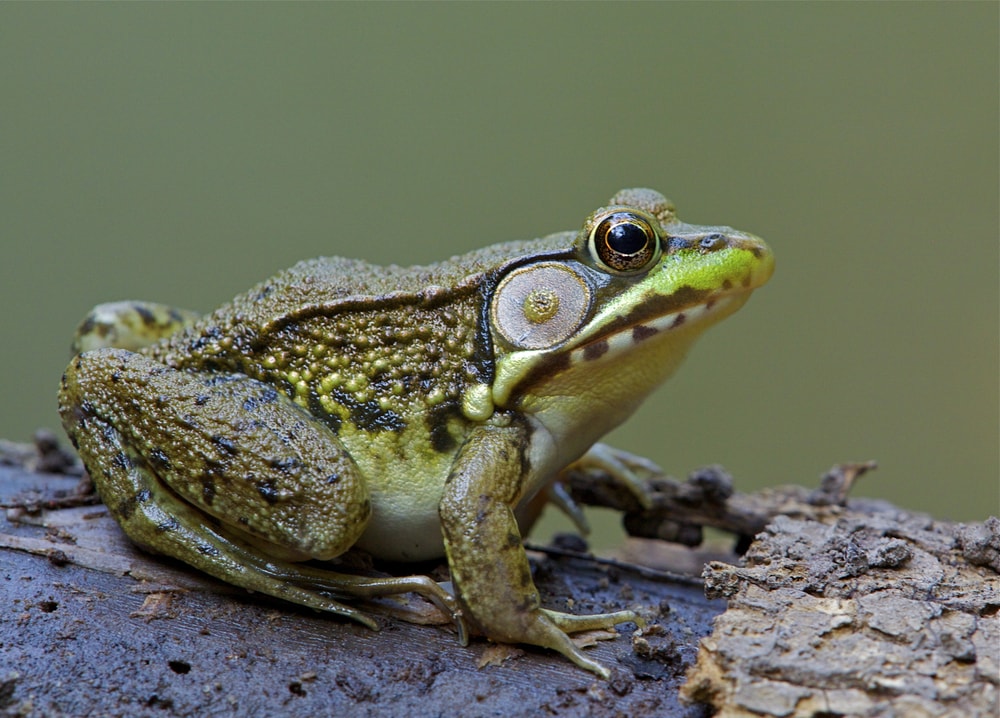
Geographic Location and Habitat
Green frogs live in the deep vegetation of wetlands in the eastern portion of the United States. Younger frogs tend to travel into meadows and wooded areas after rainfall where vegetation is less thick.
Characteristics
Their color varies from bright to olive green and brown, with lighter colors of green surrounding the sides of the head. Their underbellies tend to be yellow, tan, or white.
Their external eardrums, called tympanums, often stick out as they are located on the side of the head just below the eyes and are dark brown with a green center. Green frog eyes are a beautiful golden-orange color.
Reproduction and Life Cycle
These frogs do not have to migrate to their breeding sites as they already live in wetland areas or near permanent bodies of waters such as lakes. The breeding season lasts from April to late summer.
Females lay their eggs along the shores of shallow bodies of water and clutch size varies from 1,000 eggs to as many as 7,000. Tadpoles take approximately three months to metamorphose into froglets.
Diet
Green frogs will eat just about anything that they can fit into their mouth. This includes insects and other creatures, such as:
- Spiders
- Crayfish
- Small frogs
- Tadpoles
- Minnows and other small fish
- Snails
- Newts
3. Colorful Frogs
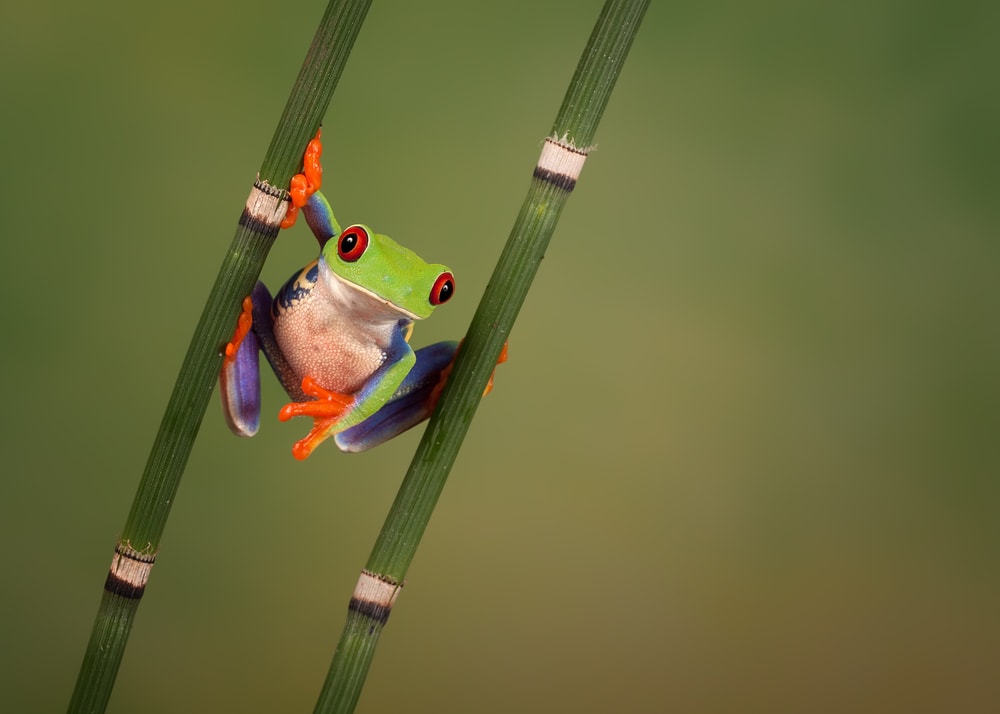
There are many other frog species that are just as colorful as the poison frog species, but they don’t belong in the Dendrobatidae family.
3.1 Madagascar Tomato Frog (Dyscophus antongilii)
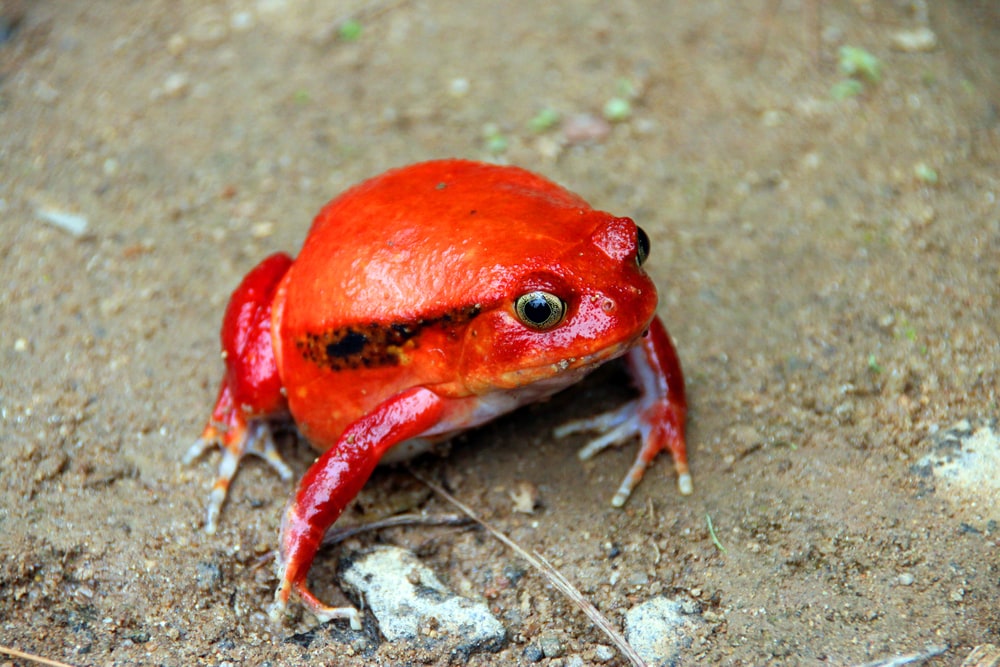
Geographic Location and Habitat
As the name states, the Tomato Frog is native to Madagascar and lives primarily in rainforests and wooded coastal areas. They may also be found in urban areas with soft soils or sands to burrow. They like to hang out in wet or dry underbrush as well.
Characteristics
The name of the Tomato Frog is perfect as these critters resemble a plump, vibrant red tomato. They also have golden-yellow to orange coloration around their sides and on parts of their head with a white underbelly. They are quite round in shape and females measure to 8.5-10.5 cm (3.3-4.1 in.) long while males are a bit smaller, ranging between 6-6.5 cm (2.4-2.6 in.).
Males and females differ in color. Male tomato frogs are less vibrant than females and are often more brown in color. Young froglets begin to develop their color a few months after hatching, but are born brown to black.
In 2017, the IUCN listed this species’ conservation status as Least Concern, but the population is decreasing due to water pollution and collection for international pet trade. They are not severely toxic to humans, but they do have the ability to excrete a mucus from their skin that can potentially cause an allergic reaction or skin irritation.
Reproduction and Life Cycle
Tomato frogs breed year-round, but most actively breed after heavy rainfalls when there is a plethora of water to lay eggs. Females lay eggs in slow-moving or stagnant waters. Female frogs live up to 11 years and males have a shorter lifespan of 7 years. In captivity, they can live more than 12 years.
Diet
Tomato frogs feed on insects, small invertebrates, and arthropods.
3.2 Golden Mantella
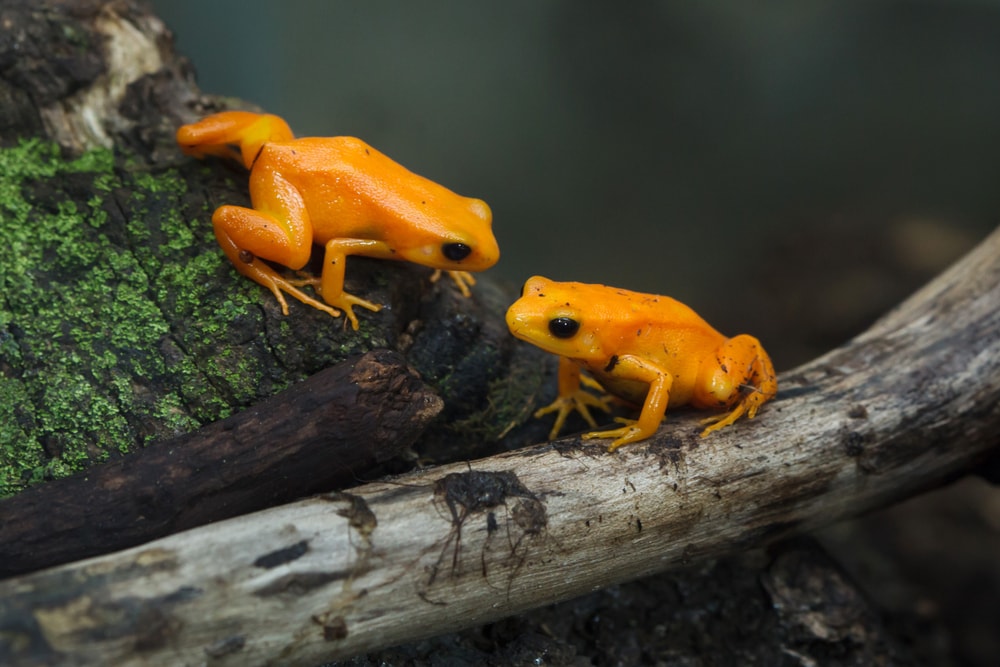
Geographic Location and Habitat
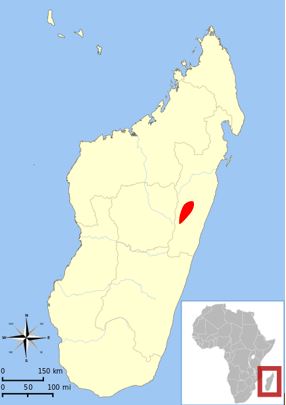
OJJ / CC BY-SA 4.0 / Wikimedia commons
Golden mantella frogs are native to the central-eastern portion of Madagascar. Their habitat is primarily in vegetation within close range of swampy sites. They can also be found in panadanus forests.
Characteristics
Golden mantellas can be yellow, orange, or reddish-orange in color and may often be mistaken as a poison frog due to their vibrance. Even though their diet causes them to retain toxins, they belong to the Mentellidae family.
They are fairly small frogs and only reach about 2.5 cm (1 in.) in length. Females are typically larger than males.
The Golden Mantella was listed as Endangered on the IUCN Red List in 2018. Their population is decreasing due to various human activities such as urbanization, mining and quarrying, and logging. They are also prey to a number of invasive species.
Reproduction and Life Cycle
Golden mantellas breed after the first heavy rainfall of the year. Females will lay approximately 20 to 60 eggs within a clutch and they are fertilized instantly by the male. The eggs are scattered amongst moist leaf litter or moss. Within two weeks the eggs will hatch and tadpoles will be washed into bodies of water nearby.
Metamorphosis takes longer than other species. It takes approximately 70 days for tadpoles to metamorphose into froglets. The froglets take a year to fully mature into adults, but they receive their golden-orange colors within just a few weeks after they mature out of the tadpole phase. Their lifespan is about eight years.
Diet
Golden mantellas are insectivorous and feed on a variety of insects, such as:
- Ants
- Termites
- Fruit flies
3.3 Spotted tree Frog (Nyctixalus pictus)
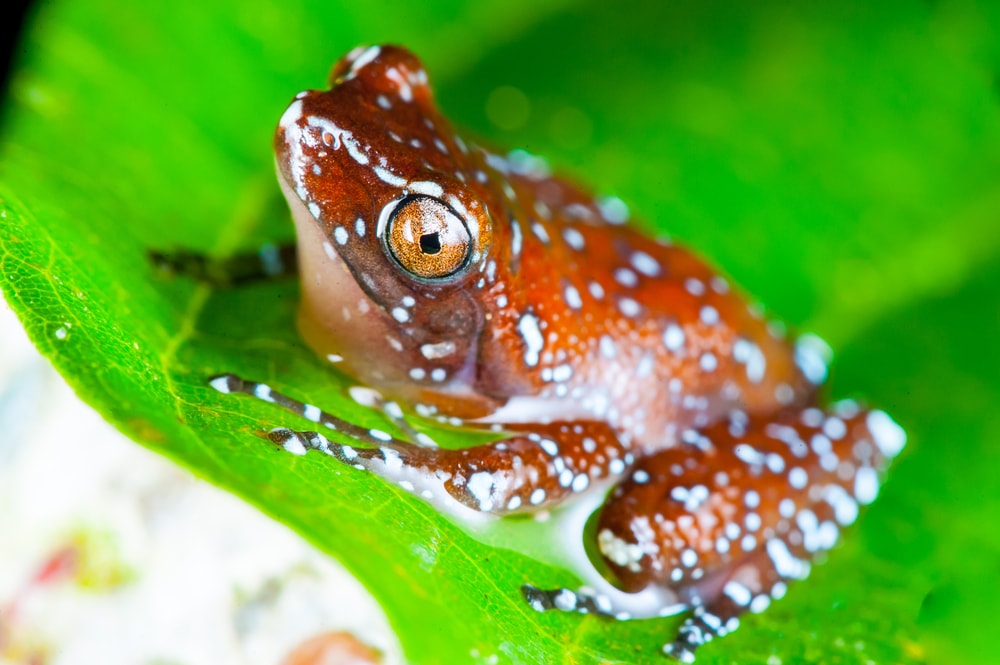
Often called the “Cinnamon Frog”, the Spotted Tree Frog is in the Rhacophoridae family and could also make it under the cute frog category.
Geographic Location and Habitat
Spotted tree frogs can be found in various locations within Southeast Asia such as Thailand, Malaysia, the Philippines, Indonesia, Brunei, and Singapore. They reside in subtropical and tropical lowlands of rainforests, primarily in low vegetation that is moist.
Habitats of the Cinnamon Frog are threatened by logging and deforestation. Their conservation status is Near Threatened according to the IUCN, last assessed in 2004.
Characteristics
Female cinnamon frogs tend to be larger than males with an average length of 1.5 inches (3.8 cm) and males averaging 1.3 inches (3.3 cm). They are nocturnal animals and most active at night.
Spotted tree frogs get the Cinnamon nickname because of their color. They tend to be light brown, tan, or light red-orange in color with white specks.
Reproduction and Life Cycle
Since spotted tree frogs are primarily arboreal, females lay their eggs in tree pockets filled with water. When the eggs hatch, tadpoles drop into bodies of water below. Their lifespan is approximately 10-14 years.
Diet
Spotted tree frogs are insectivorous and feed on a number of flying insects.
3.4 Red-Eyed Tree Frog (Agalychnis callidryas)
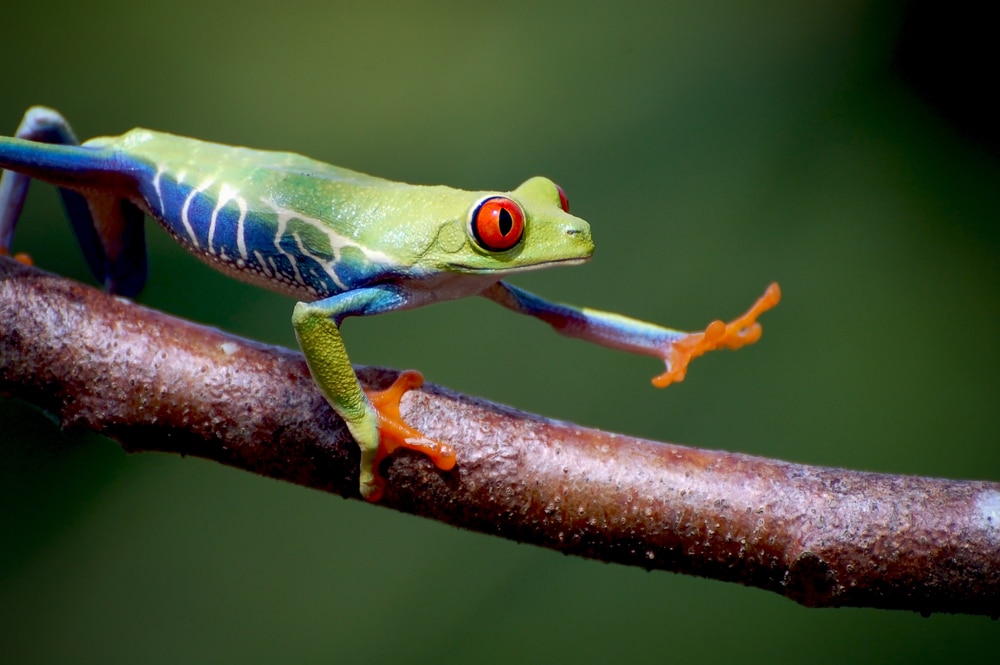
The Red-Eyed Tree Frog is kind of like the poster-frog of the rainforest and you’ve probably seen pictures of it before. They could possibly be given the title of the most famous frog in the world. Red-eyed tree frogs are in the Phyllomedusidae family.
Geographic Location and Habitat
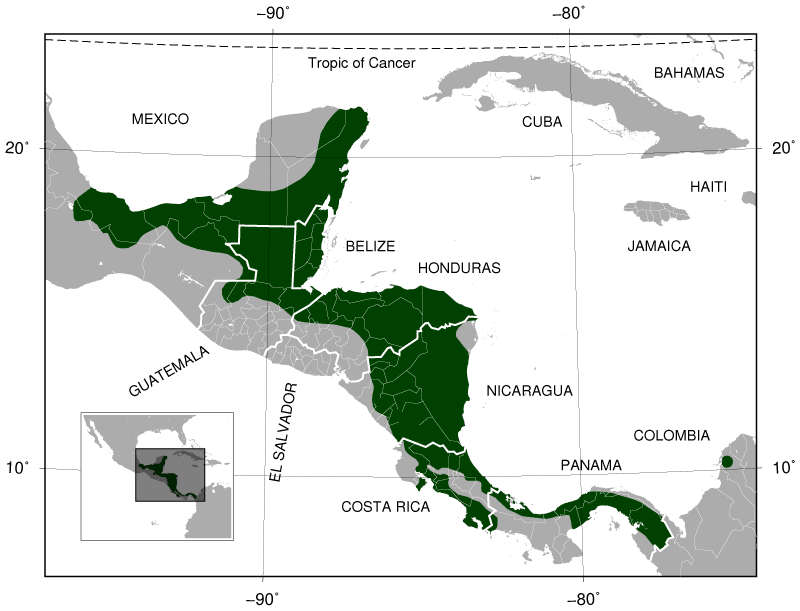
Darekk2 and the IUCN Red List spatial data / CC BY-SA 4.0 / wikimedia commons
Red-eyed tree frogs live in the humid lowland rainforests of Central America, but can also be found in southern Mexico. They like to stay close to rivers and other water sources to keep their skin wet.
Most of their adult life is spent living up in the trees, but they may travel closer to the rainforest floor during breeding season.
Characteristics and Behavior
Red-eyed tree frogs are easily identifiable by their bright red-colored eyes, vibrant green skin, and blue color on their sides. Their toes are a yellow-organish color and have suction disks that help them climb and stick to leaves. They also have three eyelids for each eye. These critters are 2-3 inches (5-12.7 cm) in length.
Red-eyed tree frogs are nocturnal and often sleep on the undersides of leaves during the day. They have the ability to shield their colors when sitting, so only their green is showing. This is to help with their defensive strategy of “startle coloration”, where they reveal their red eyes and blue color to predators to give them time to escape.
Reproduction takes place during the rainy season and starts off with a mating ritual. Males will croak and quiver to attract females. The egg-laying process of red-eyed tree frogs is quite intricate as females will lay eggs on the underside of a leaf that hangs above a pool of water and the eggs hatch within minutes. The tadpoles then wash down into the water.
Diet
The Red-Eyed Tree Frog feeds on various insects, such as:
- Crickets
- Moths
- Flies
- Grasshoppers
- Smaller frogs
4. Crazy Cool Frogs
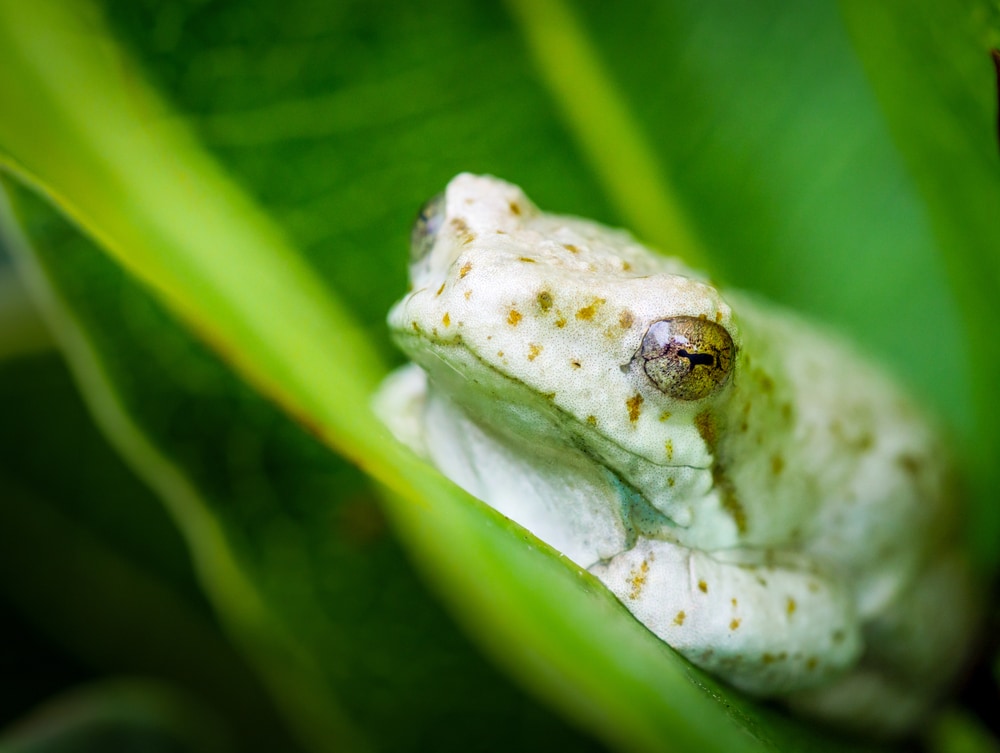
There are so many frog species with unique characteristics that help them adapt to their environment. Let’s have a look at some of the coolest looking frogs around the world.
4.1 Vietnamese mossy Frog (Theloderma corticale)
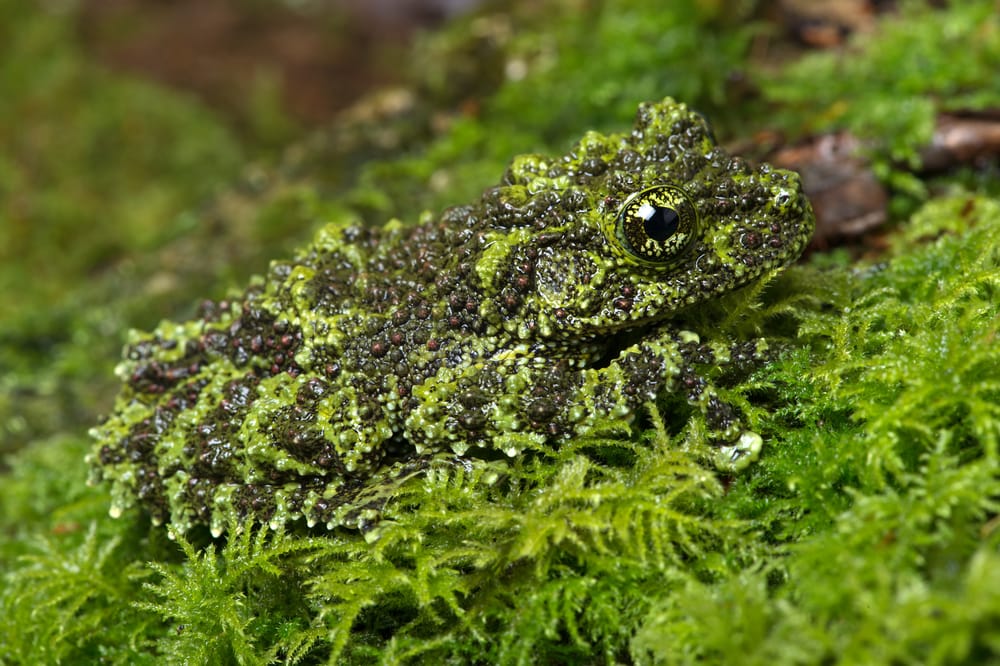
Geographic Location and Habitat
The Mossy Frog is native to the northern region of Vietnam. They can be found on the banks of streams that meander throughout rocky mountains or in evergreen forests. They are terrestrial and live on the forest floor where they blend in with the mossy rocks.
Characteristics and Behavior
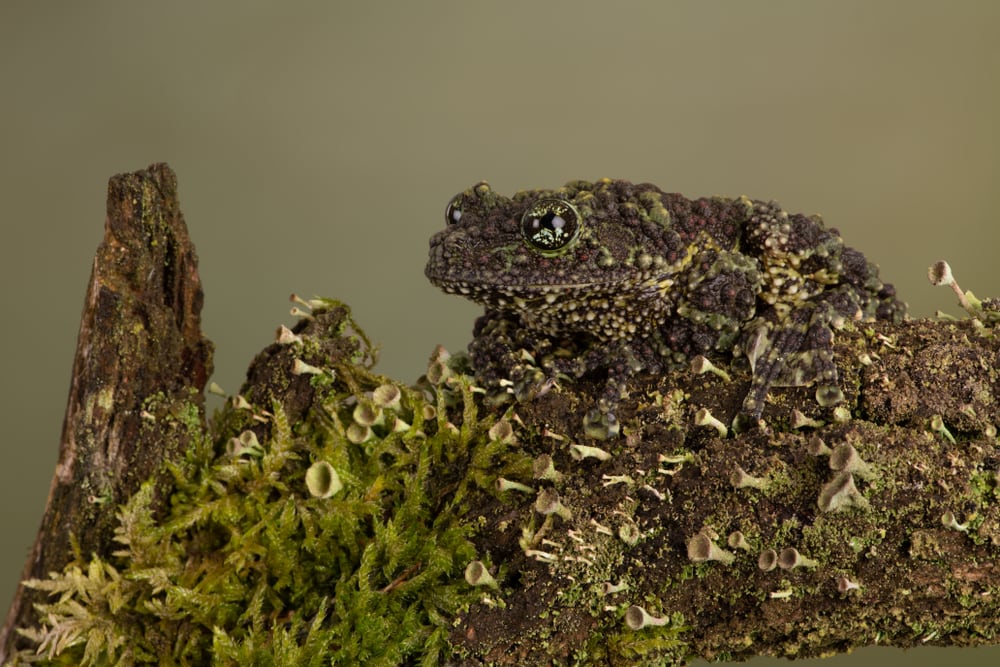
These mossy critters are semi-aquatic so they spend a lot of their time hopping around bodies of water and moist areas. They are experts in camouflage and spotting one could be extremely difficult. Their green and brown textured skin and green eyes to match helps them blend into their habitat very well.
Mossy frogs will play dead when they feel threatened and use their camouflage as a tactic to hide from predators. Males are about 7-8 cm (3.5 in.) in length and females are slightly larger. They are also nocturnal.
Reproduction and Life Cycle
Females lay 8-10 eggs within a clutch in rock cavities above water level. This is to help prevent aquatic predators from eating the eggs. The eggs hatch in one to two weeks and turn into froglets within 90 days.
Diet
Mossy frog diets vary as they will feed on whatever they can fit into their mouth and is available to them. This would include various insects and aquatic bugs that live near bodies of water.
4.2 Malayan Horned Frog (Megophrys nasuta)
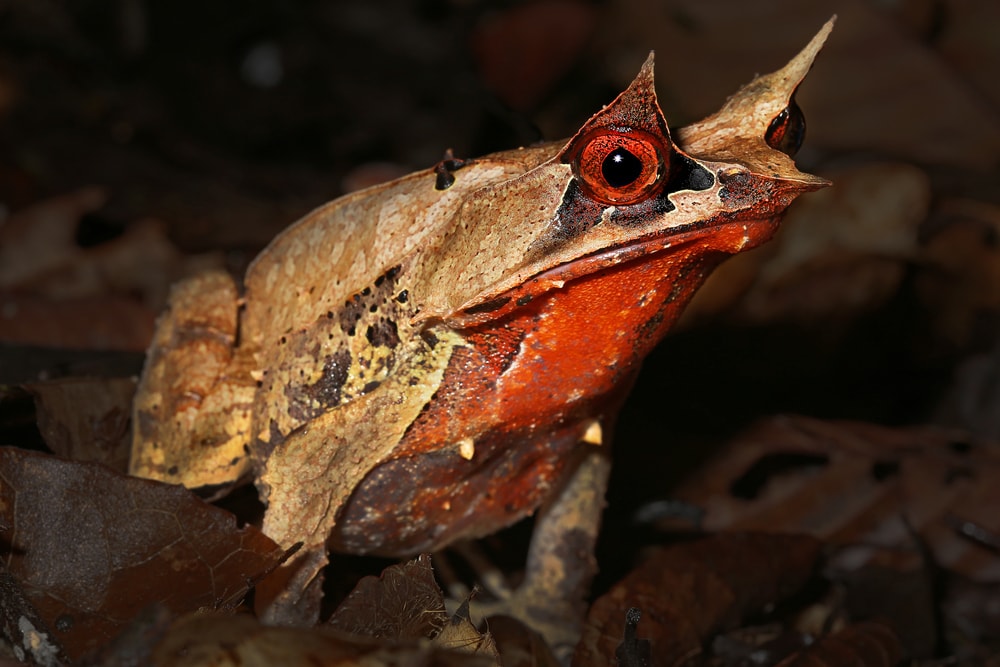
Geographic Location and Habitat
Malayan horned frogs can be found in the Southeast Asia region in places such as southern Thailand, Malaysia, Singapore, and Borneo. They live in lowland and submontane forests and once matured, they are completely terrestrial.
Characteristics
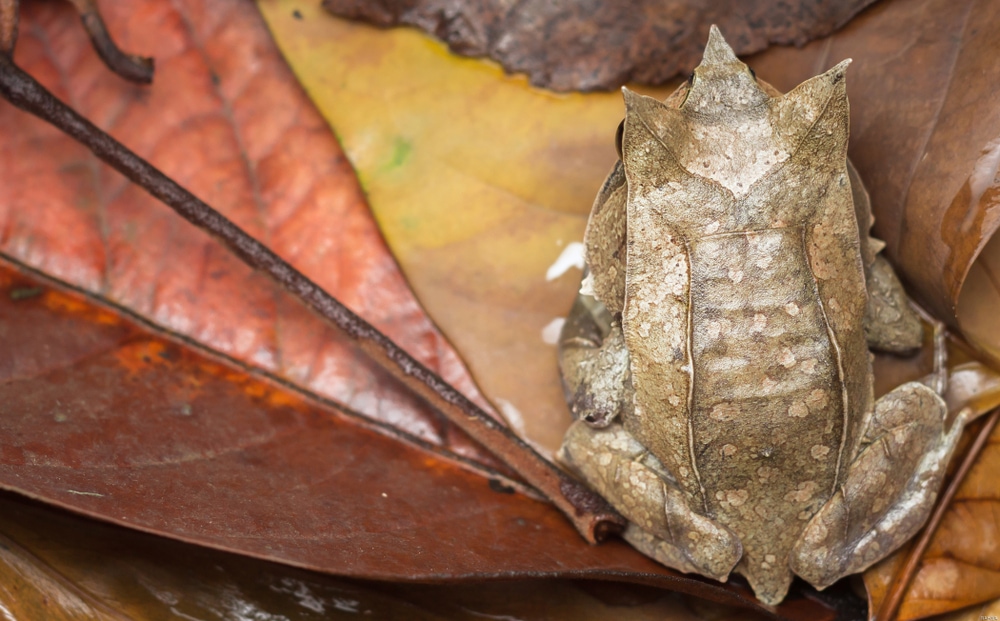
The Malayan Horned Frog is also known as the Long-nosed Horned Toad and is a part of the Megophryidae family. They have a striking appearance with a small pointy nose and elongated spikes that pass over their eyes. Their appearance resembles a leaf and is great for blending in with leaf litter on the forest floor.
Their coloration varies from dark to light brown on their backs and dark brown underbellies accompanied by light-colored markings. Their conservation status was last assessed in 2020 by IUCN as Least Concern.
Reproduction and Life Cycle
Females lay their eggs underneath rocks, logs, or other structures in streams. They take approximately one week to hatch and can take anywhere between two and a half to seven months to metamorphose into froglets depending on the temperature.
Diet
These leaf-like critters are opportunistic hunters and feed on a variety of insects and gastropods, such as:
- Crickets
- Cockroaches
- Worms
- Locusts
- Slugs
- Snails
4.3 Painted Reed Frog (Hyperolius marmoratus)
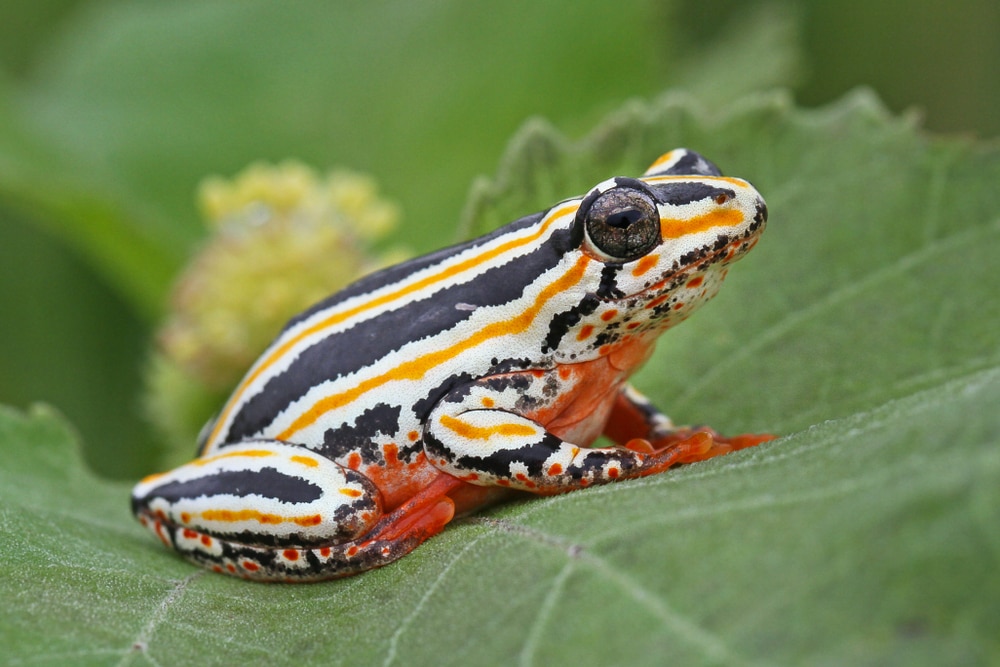
Geographic Location and Habitat
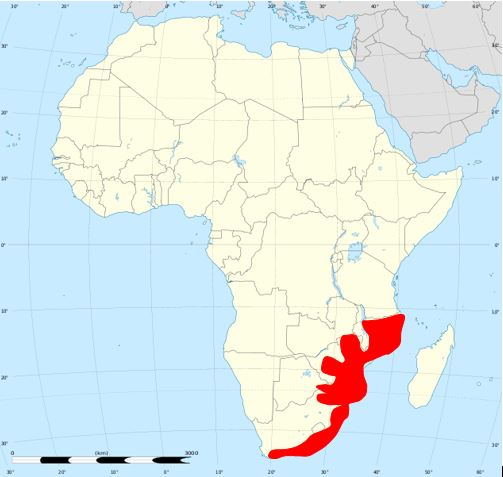
OJJ / CC BY-SA 4.0 / wikimedia commons
Painted reed frogs are native to sub-Saharan Africa and can be found near water sources in grasslands or savannas. They also frequent lowlands during the rainy season.
Characteristics
The Painted Reed Frog is truly a work of art. They can vary in color, but tend to have a combination of black to dark brown, white, yellow, and light orange stripes that run down their body. Their underbellies tend to be light orange or white.
Reproduction and Life Cycle
Females will approach males during breeding season when they are ready to lay eggs. Females can produce a clutch of up to 600 eggs and will lay them in a pond that the male chose as his calling territory. Breeding season begins in the spring upon the first rainfall and continues into late summer.
The eggs hatch within one week and tadpoles will metamorphose into froglets within two months. Once froglets mature into adults, they will develop their distinct color pattern. Their lifespan in captivity is fairly short as they only live for 4.5 to 5 years.
Diet
Painted reed frogs are insectivores and feed on a variety of insects and arthropods.
4.4 Glass Frog (Hyalinobatrachium fleischmanni)
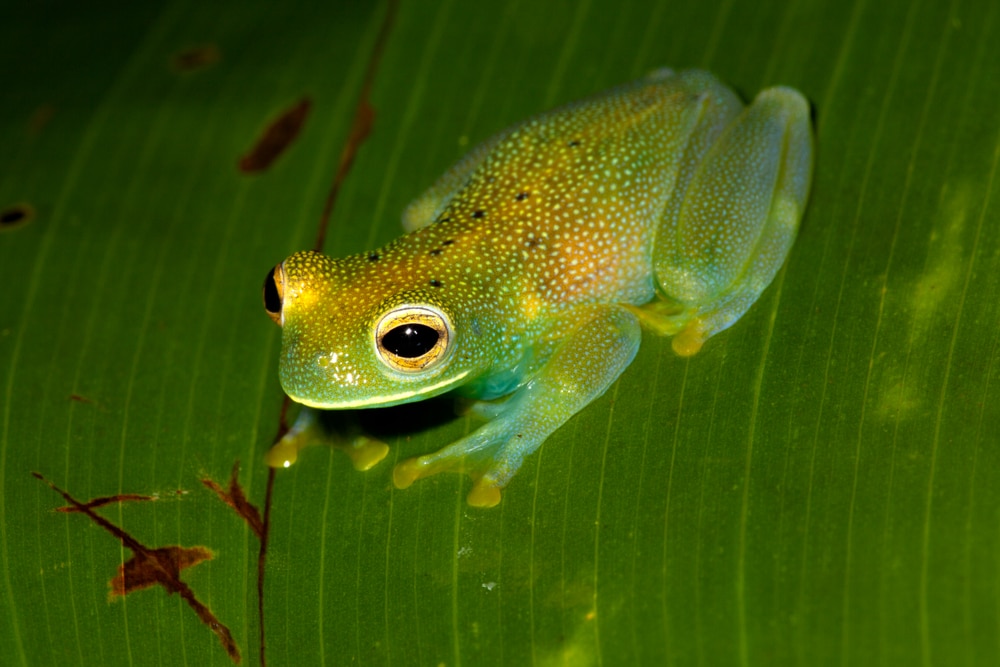
Glass frogs are a part of the Centrolenidae family and known for their translucent appearance. There are several subspecies within the Centrolenidae family, but in this case we are discussing the Hyalinobatrachium fleischmanni Northern Glass Frog species.
Geographic Location and Habitat
Northern glass frogs are native to Central and South America and Mexico. They live in neotropical regions in wet montane forests along rocky streams.
Characteristics
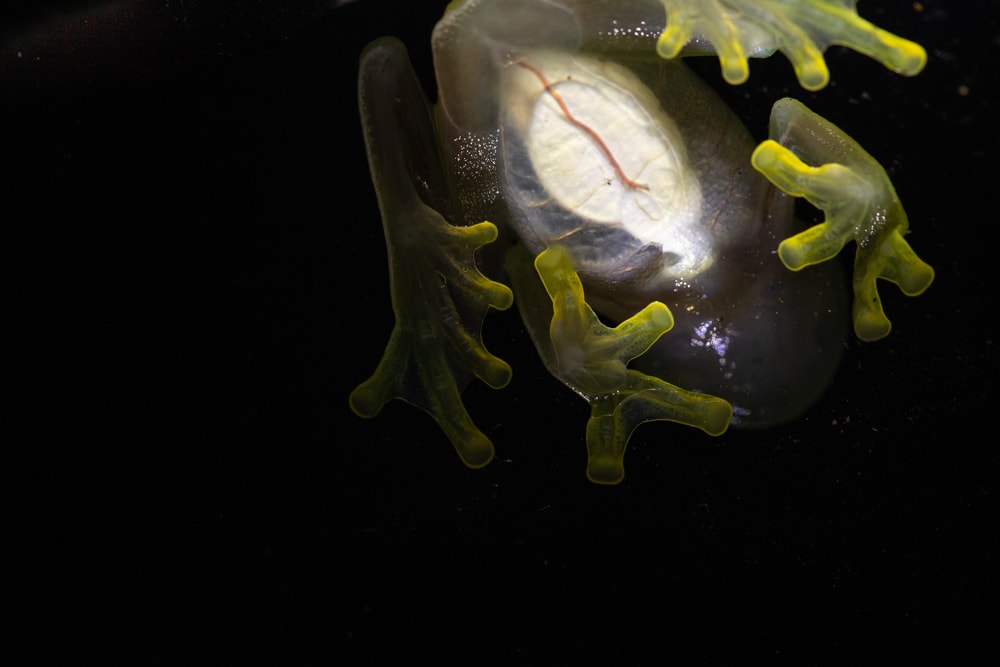
Glass frogs have a fascinating appearance as their underbellies are completely transparent. Their transparency allows us to see their organs and even their heart beating! They are light green in color, sometimes covered with light yellow or white spots, and have green bones.
Scientists believe their green bones are an adaptive feature as it helps them blend in more with their environment. Northern glass frogs are fairly small and reach lengths up to 2.5 cm (1 in.).
Reproduction and Life Cycle
The breeding season of these transparent frogs is between the rainy season months of May and October. Females lay their eggs on the underside of leaves above water and can lay up to 30 eggs per clutch. The eggs are highly desired by glass frog predators, such as snakes, and a majority of the eggs may not hatch before being eaten.
Glass frog eggs hatch within two weeks, but the tadpole to froglet stage is slow and it can take as long as two years for a tadpole to form into a froglet.
Diet
Glass frog diets are similar to other species and mainly consists of small invertebrates, spiders, and other small insects.
4.5 Shovel-Headed Tree Frog (Triprion spatulatus)
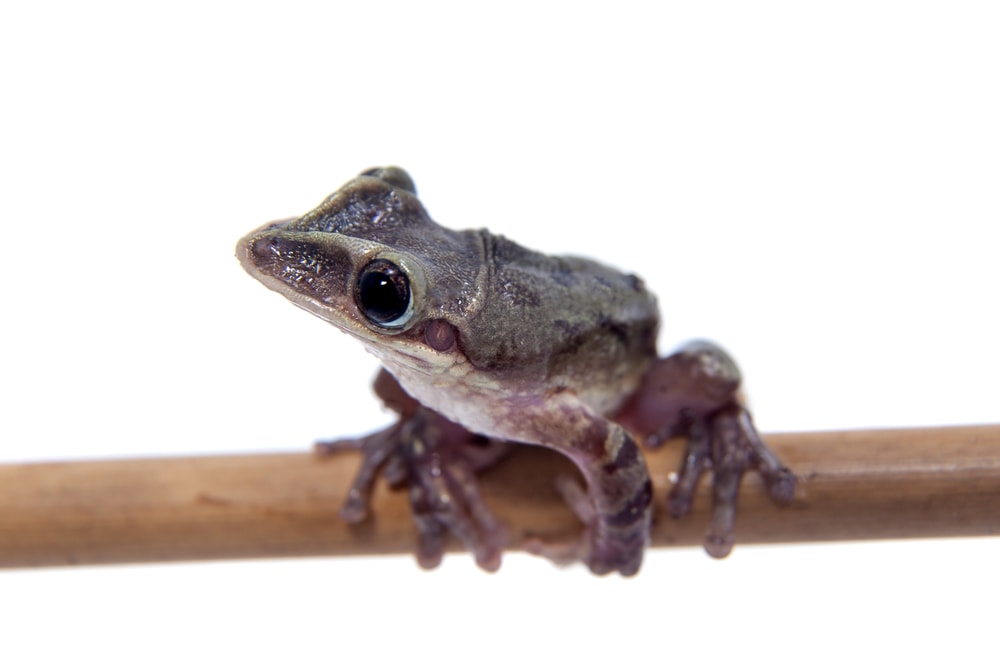
Geographic Location and Habitat
Shovel-headed tree frogs are native to the western coast of Mexico and are arboreal and terrestrial. They live in forests, shrublands, and wetlands.
Characteristics
The name of these critters is very fitting as shovel-headed tree frogs have a triangular-shaped head that narrows towards the mouth. Males can be 6.1 to 8.7 cm (2.4-3.4 in.) in length and females are slightly larger at 7.5 to 10.1 cm (3-4 in.).
Their colors range from grayish-green, light tan, to olive-gray. Their underbellies are white or light tan or brown. The shovel-headed tree frogs conservation status is Least Concern as of 2019.
Reproduction and Life Cycle
Breeding season is during the rainy season between June and November. Females will lay their eggs near temporary pools of water that appear after heavy rainfall. Males will attract females by letting out a mating call.
Diet
Shovel-headed tree frogs have a “sit and wait” hunting technique as they will wait until insects come along and use their sticky tongues to catch their next meal.
Their diet mostly consists of:
- Spiders
- Grasshoppers
- Crickets
5. Cute Frogs
There are many cute frogs and then there are some frogs that are downright adorable.
5.1 Gray Tree Frogs (Hyla versicolor)
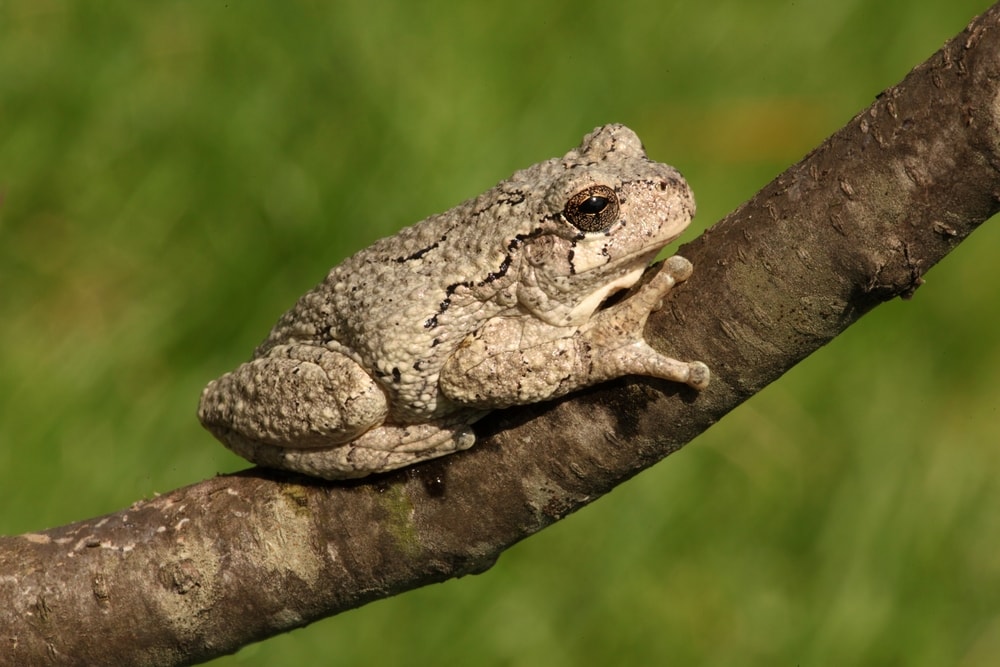
Gray tree frogs are very cute. They are usually gray in color to blend in with tree bark, but can also quickly change to greenish-gray or brown color to match their surroundings.
They live in deciduous woodlands near water on the eastern half of the United States. These cute critters are nocturnal and they’re also able to freeze during the winter and thaw out in the springtime.
5.2 Desert Rain Frog (Breviceps macrops)
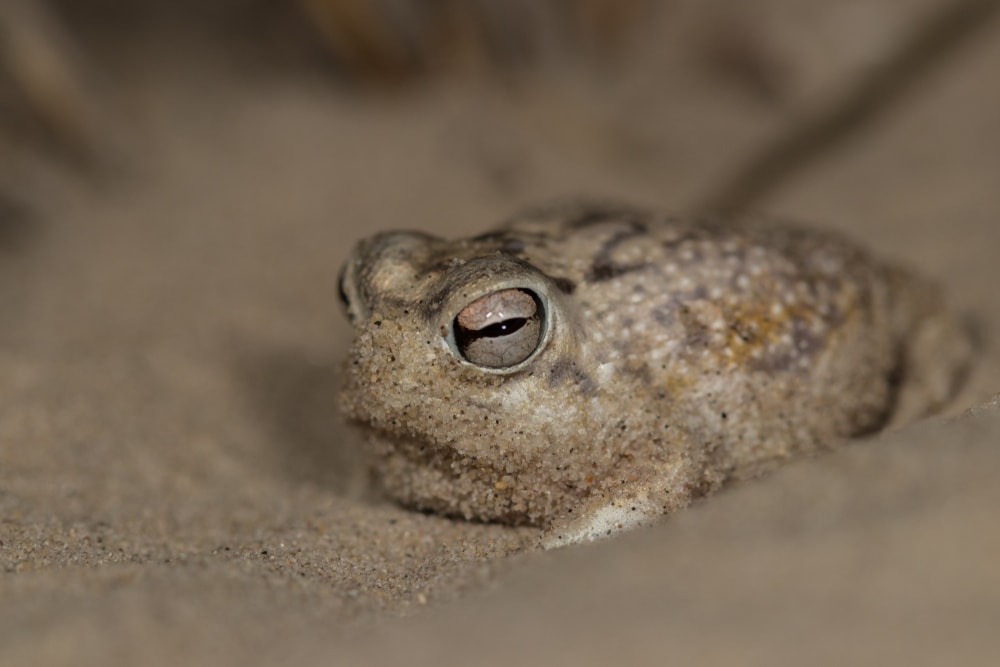
The Desert Rain Frog is very cute because of its plump, round body and pouty face.
These critters are master burrowers and can be found in the coastal sand dunes of South Africa. They are nocturnal and spend most of the daytime hiding underground.
Their diet consists mostly of insects, such as moths and beetles. Unfortunately, these cute frogs are Near Threatened as of 2016, largely due to tourism.
5.3 Cranwell’s Horned Frog (Ceratophrys cranwelli)
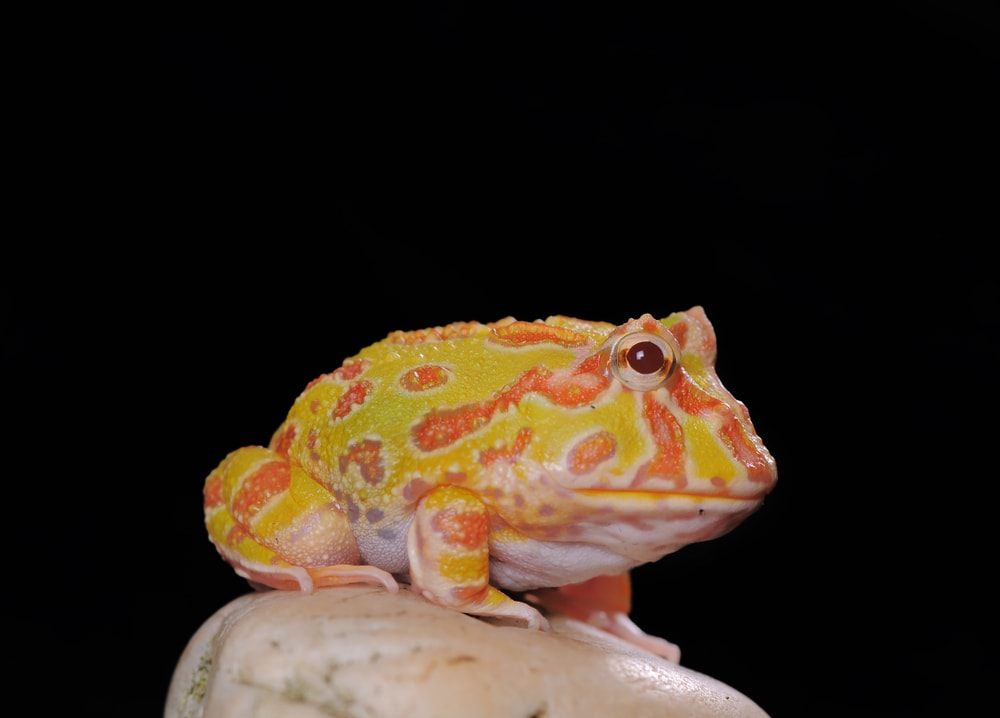
Known as the Pacman Frog, the Cranwell’s Horned Frog is a part of the genus Ceratophrys. There are 8 different subspecies. Cranwell’s horned frogs have large heads and small bodies that land them on the cute frogs list.
They reside in northern regions of South America. Pacman frogs have very prominent eyes that bulge out of their head, wide mouths, and rounded bodies. Their looks make them a highly desired pet for amphibian lovers.
Smallest Frog in the World
6. Paedophryne amauensis
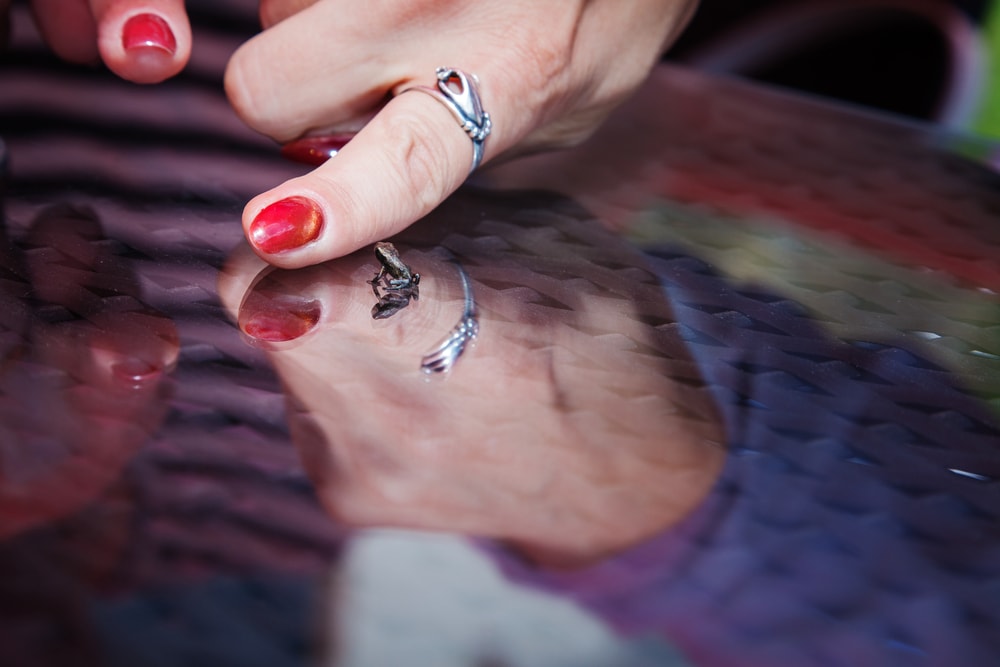
The Paedophryne amauensis is the smallest frog in the world. It was discovered in Papua New Guinea and measured to be 7.7 mm (0.3 in.) in length. It was also given the title of the world’s smallest vertebrate.
This tiny frog was discovered in 2012 and belongs to the Microhylidae family. It has amber-colored eyes and it’s body is reddish-brown with dark brown splotches, making it easily camouflaged amongst leaf litter.
They are terrestrial in nature and do not have a tadpole phase. They feed on various small invertebrates including acarians and collembolans.
You may also like: Learn More about Amphibians and the More Than 30 Amazing Different Amphibian Species: Complete with Images, Facts, and More!
Largest Frog in the World
7. Goliath Frog (Conraua goliath)
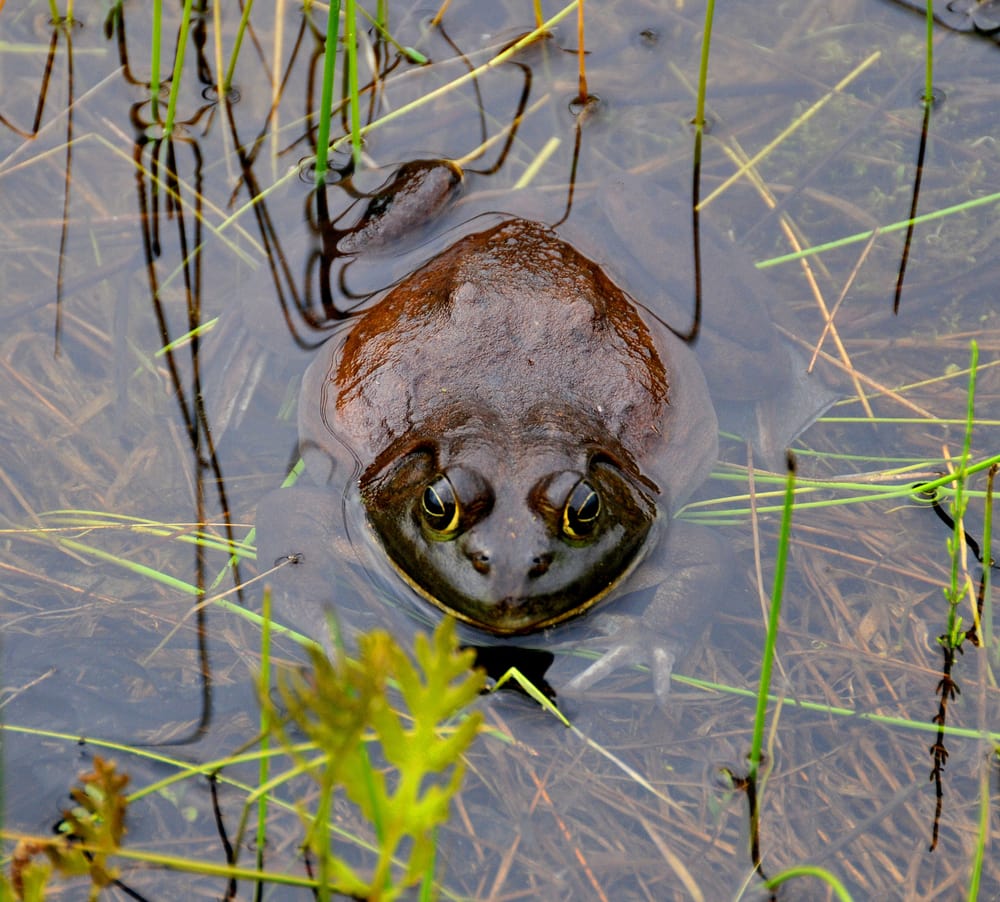
The Goliath Frog surely lives up to its name as this frog is massive. They can reach lengths up to 13 inches (32 cm) and weigh over 3 pounds. Goliath frogs live in West Africa within equatorial Guinea and Cameroon.
These giant frogs live in the humid climates of rainforests and reside alongside rivers and near waterfalls.
Males attract females with a whistle-like call, but they do not have vocal sacs. Instead, they open their mouths to make the noise. Females will go to the male to mate and lay hundreds of eggs at the bottom of a river or stream.
You would think that because of their large size, goliath tadpoles would also be much larger than the average-sized frog, but this is not the case. Goliath frog tadpoles are fairly normal size and metamorphose into froglets within three months.
Goliath frogs have a similar diet to other frogs. They eat insects and other creatures such as:
- Fish
- Crustaceans
- Newts and salamanders
- Small mammals
Rarest Frog in the World
8. American Cinchona Plantation Treefrog (Isthmohyla rivularis)
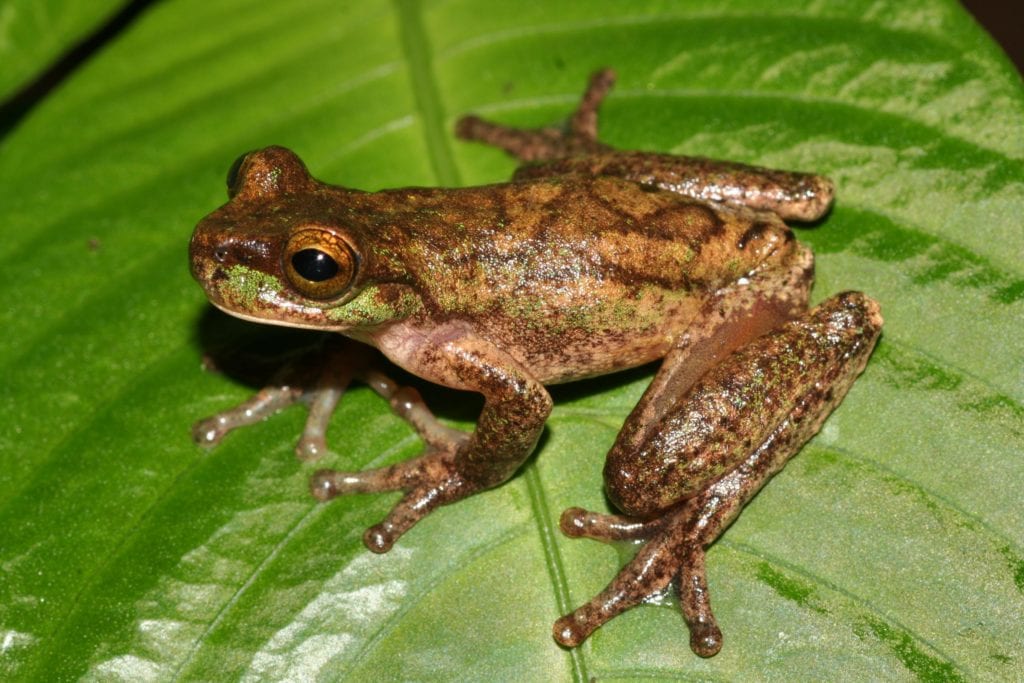
The American Cinchona Plantation Treefrog is arguably the rarest frog in the world as it was previously thought to have gone extinct until rediscovered in 2007.
This frog species is Endangered according to IUCN’s assessment in 2019. It is believed that there are less than 3,000 mature frogs in existence and their population is decreasing due to agricultural practices and logging. They are also threatened by non-native invasive species.
American cinchona plantation tree frogs live in Costa Rica and Panama along streams in wetlands and premontane rainforests.
You may also like: Learn the 25 Different Types of Lizards Around the Globe: With Images, Facts, Descriptions, and More!
Frog Calls: How Frogs Make Their Sounds
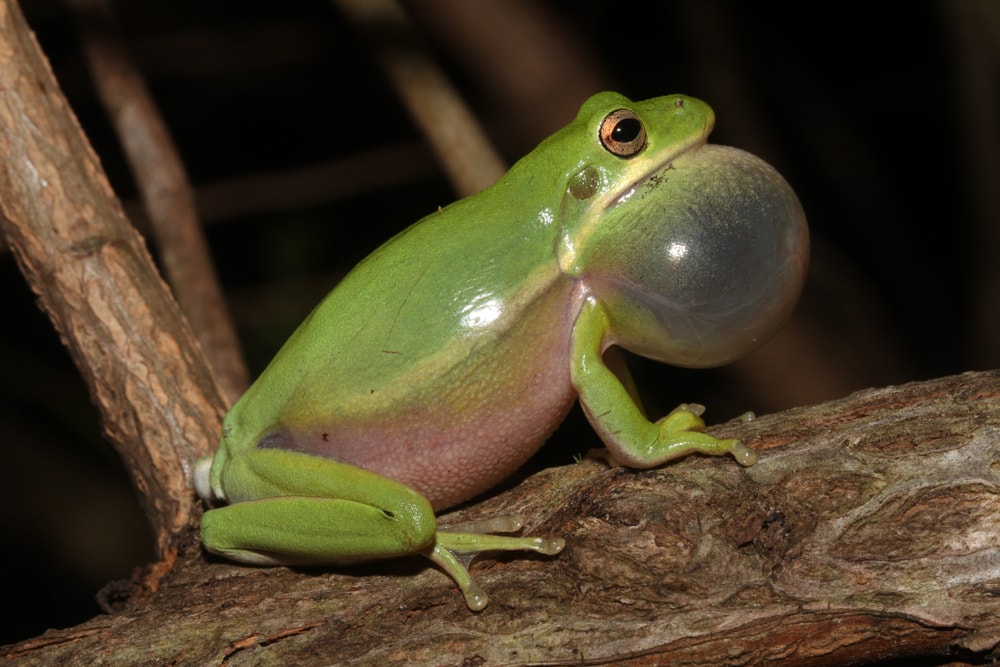
Frogs make a bunch of different sounds and they can vary by species. Frog calls can often be described as trills, peeping, whistling, honks, or clicking.
How Do Frogs Make Their Sounds?
Many frogs have vocal sacs that they use to make their sounds. The vocal sac is typically located on the sides of the neck or the mouth. This is why you may see some frogs with their vocal sac inflated under the mouth or off to the sides.
They make their sound by taking in air and pushing it back and forth between their lungs and mouth. The rate at which frogs do this can change the sound that they make. Some frog species do not have a vocal sac, such as the Goliath Frog, and will open their mouth to make calls.
Why Do Frogs Call?
Frogs call for a number of reasons, but the main two are for mating and territorial purposes. A third call is used for defense when they feel threatened and is known as a “release” call to tell their captor to let them go.
Mating

Males will call to attract females during breeding seasons. The call will often be specific for mating and females tend to only be receptive of the call and do not make calls themselves for mating.
Males may also call within an army or colony, which is a group of frogs. This is called a “frog chorus” and is very loud to attract females’ attention.
Territorial Call
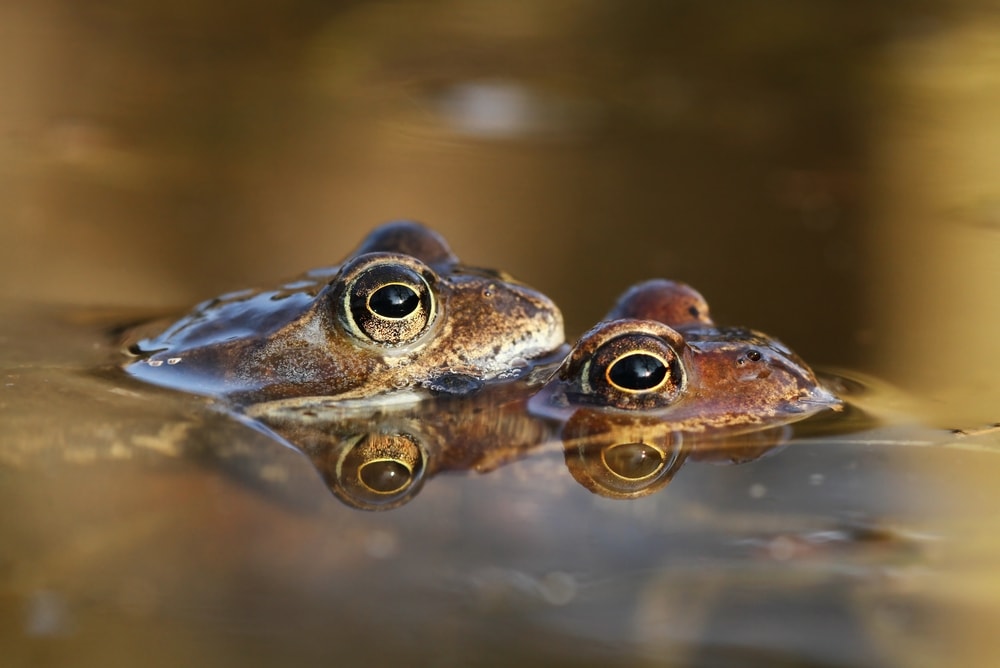
Male frogs use territorial calls during mating season to deter other male frogs from their area. Breeding season can often turn into a male frog frenzy, therefore the territorial call is to let other males know they aren’t allowed to get closer.
You may also like: Learn More About the 16 Amazing Types of Salamanders: With Images, Facts, Descriptions, and More!
Where Do Frogs Go in the Winter?
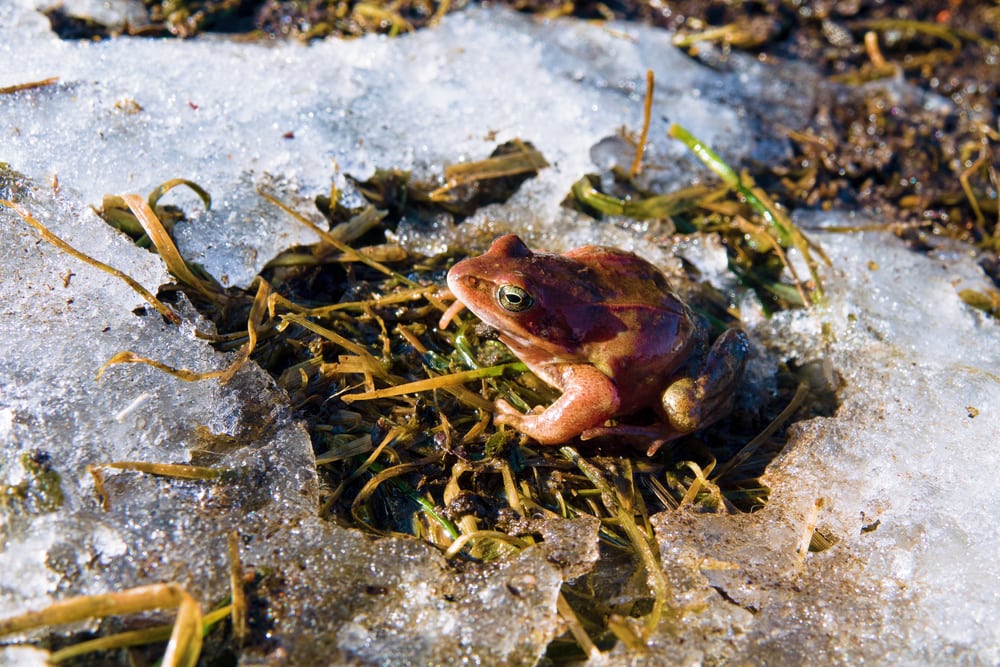
Frogs are ectothermic, which means that their internal body temperature changes with external temperatures. Frogs may migrate or hibernate in the winter depending on the species.
Frog Migration
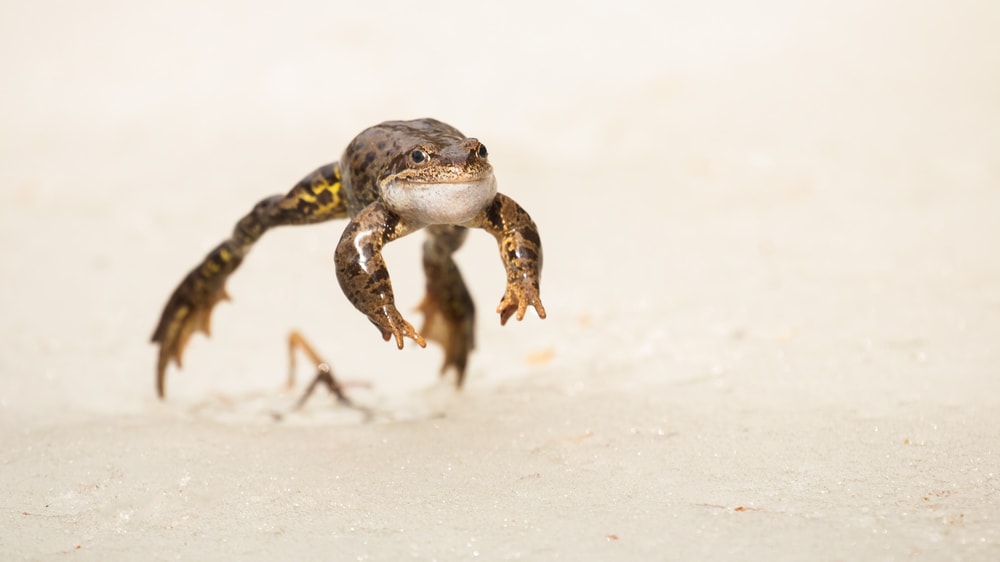
Some frog species will travel far distances from their breeding sites to migrate for the winter. Frogs that migrate will often find shallow bodies of water during breeding season to lay eggs. Once the breeding season is over, certain frog species will migrate to deeper bodies of water for the winter. As spring rolls around, frogs will migrate back to the breeding sites.
Frog Hibernation
Other frog species do not migrate during the winter, but they will hibernate. Many frogs will bury themselves beneath mud, soil, or leaf litter until it is time for spring. Some frog species, such as the Wood Frog, are able to freeze over the winter and then thaw out in the spring.
Not all frogs can freeze and come back to life, but some can produce glucose to prevent their organs from freezing. The organs will stop functioning, but once temperatures begin to rise again their organs are miraculously able to work again. This adaptation helps frogs that live in extremely cold regions, but if it gets too cold they can still die.
You may also like: Learn the 19 Species of Eels You can Find on Earth’s Water: With Images, Facts, and More!
Frogs Vs. Toads: What’s the Difference?
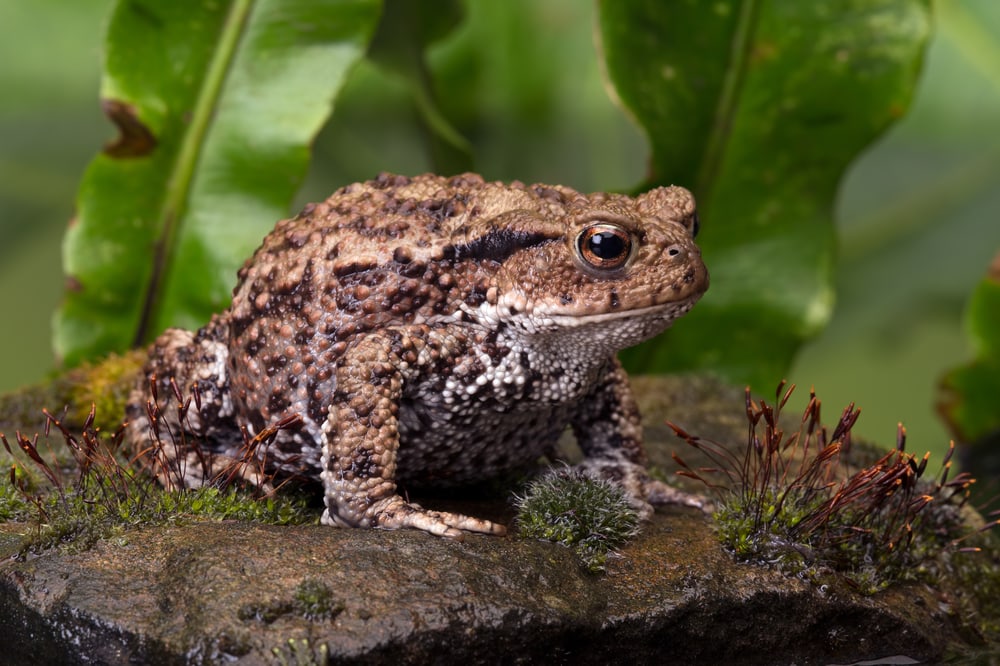
Frogs and toads both belong to the class Amphibia and order Anura. Technically, there is no scientific distinction between a toad and a frog which means that all toads are considered frogs.
With that being said, toads and frogs do have some differences.
You may also like: Learn the 20 Species of Toads and Frogs You Can Spot in Florida: With Images, Facts, and More!
Frog FAQs
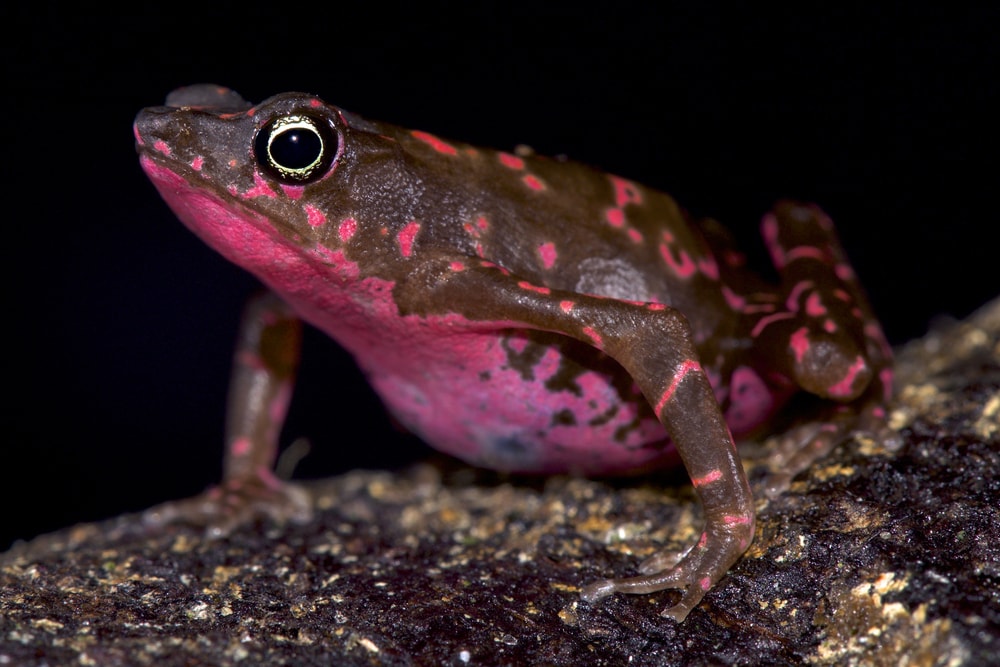
1. Are Pink Frogs Real?
If you count purple as a shade of pink, technically yes! Atelopus barbotini, most notably known as the Purple Harlequin Toad, has purple on its belly.
This frog is a part of the Bufonidae family and lives in French Guiana. The majority of their back is colored black with purple or red-orange markings and purple bellies.
There are a lot of pictures on the internet of poison dart frogs that are made out to be pink, but those are photoshopped and do not exist.
2. How Do Frogs Sleep?
There is very little scientific research done on the sleep patterns of frogs. It is confirmed that frogs do sleep and may experience different states of sleep. These sleeping states, however, cannot be compared to the stages of sleep that humans go through as frog brain functions differ from humans and they are cold-blooded, which could also factor into this discussion.
When frogs are sleeping, they tend to tuck in their limbs and head and close their eyes with their third eyelid, the nictitating membrane, which allows them to still see while resting.
Sleep patterns in frogs may differ depending on the species. This could vary depending on a number of circumstances, such as when they sleep and where they sleep. Some frogs sleep on leaves or branches high in treetops, while others may find a nice rock or log to rest on.
You may also like: Check out These 18 Wasp Species You Must Know: With Images, Facts, and More!
Frog Symbolism
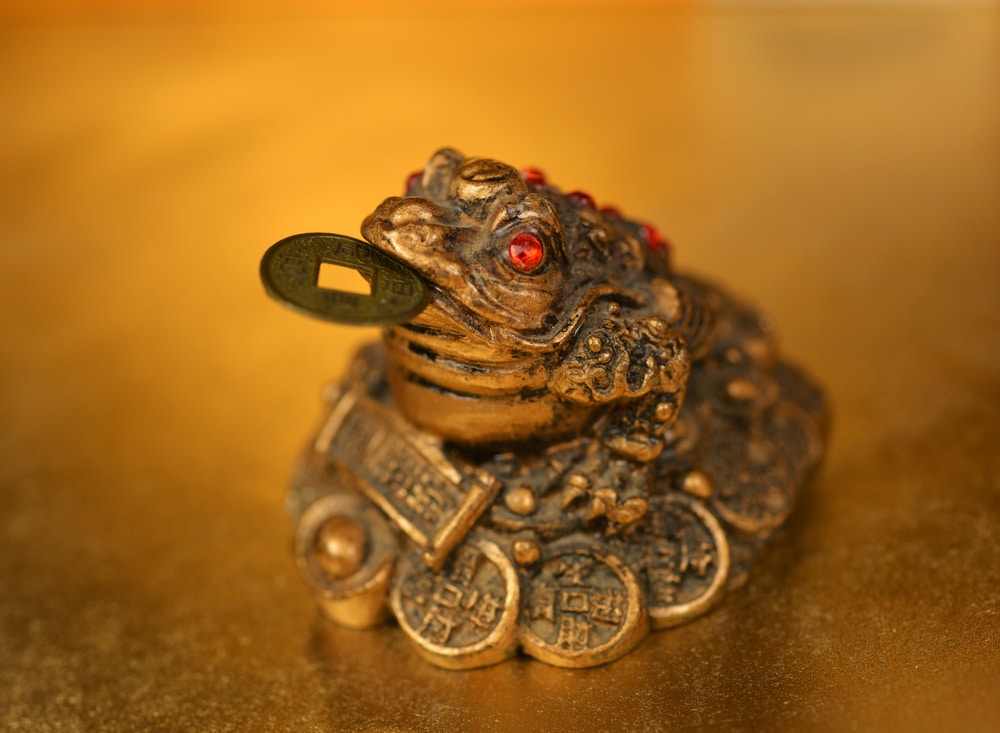
Frogs symbolize many things in various cultures. They are often viewed as a symbol of fertility, renewal, rain, and rebirth. Ancient Egyptian and Olmec tribe cultures view frogs as a sign of rebirth and transformation because of their life cycle process of changing from tadpole to frog.
On the contrary, frogs in Christianity have negative symbolism and are viewed as evil and manipulative.
The “Money Frog” or “Money Toad” is a common frog figure that dates back to ancient China. The statue of the frog sits on top of a pile of coins with one in its mouth and is seen as a symbol of prosperity and fortune.
Most Native American tribes believe frogs are a sign of fertility, rain, and have powers of healing, while other tribes see frogs in a more negative light and link them to misfortunes.








